Method and apparatus for measurement of neural response
Single , et al.
U.S. patent number 10,588,524 [Application Number 14/117,153] was granted by the patent office on 2020-03-17 for method and apparatus for measurement of neural response. This patent grant is currently assigned to Saluda Medical Pty Ltd. The grantee listed for this patent is James Hamilton Laird, Peter Scott Vallack Single. Invention is credited to James Hamilton Laird, Peter Scott Vallack Single.
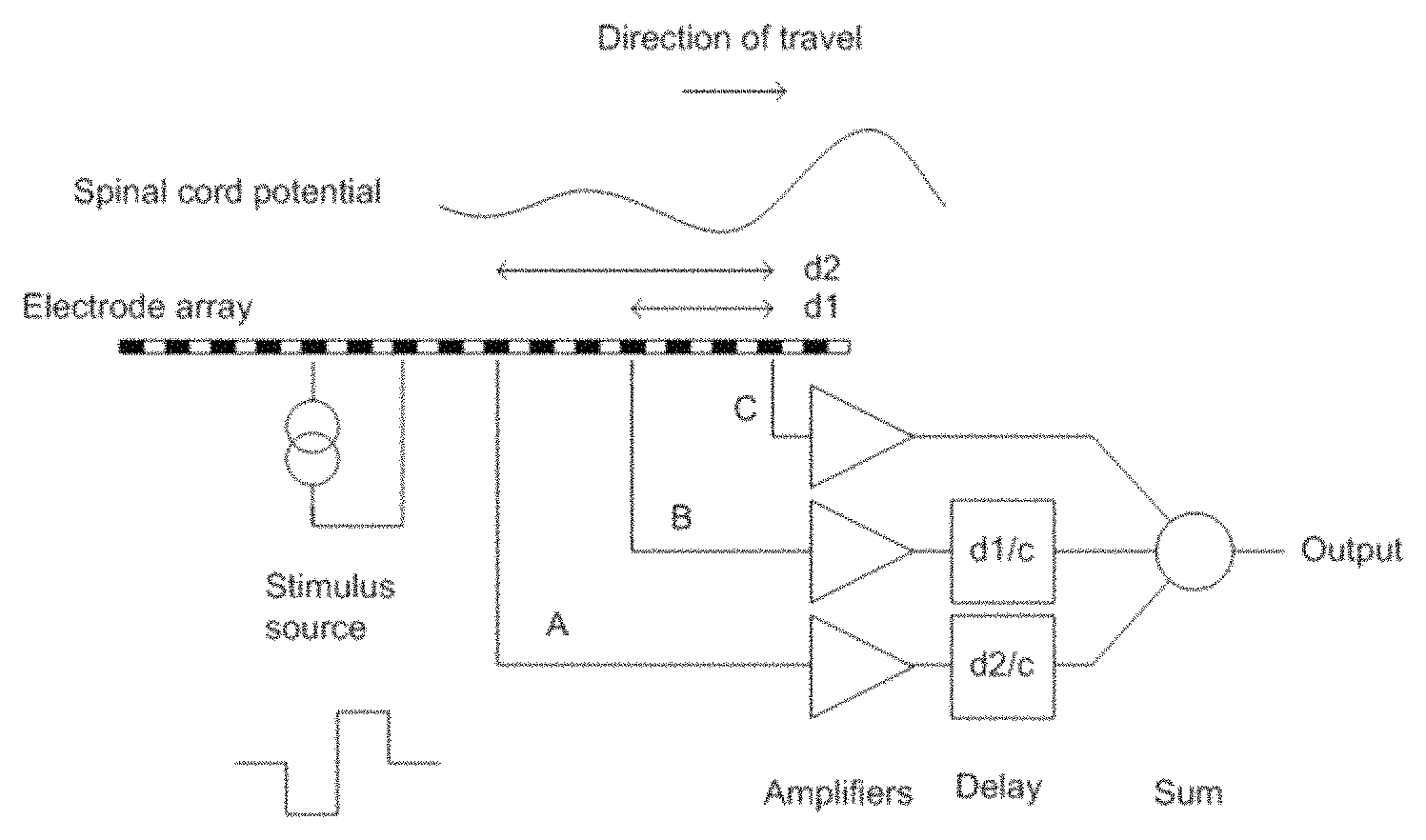

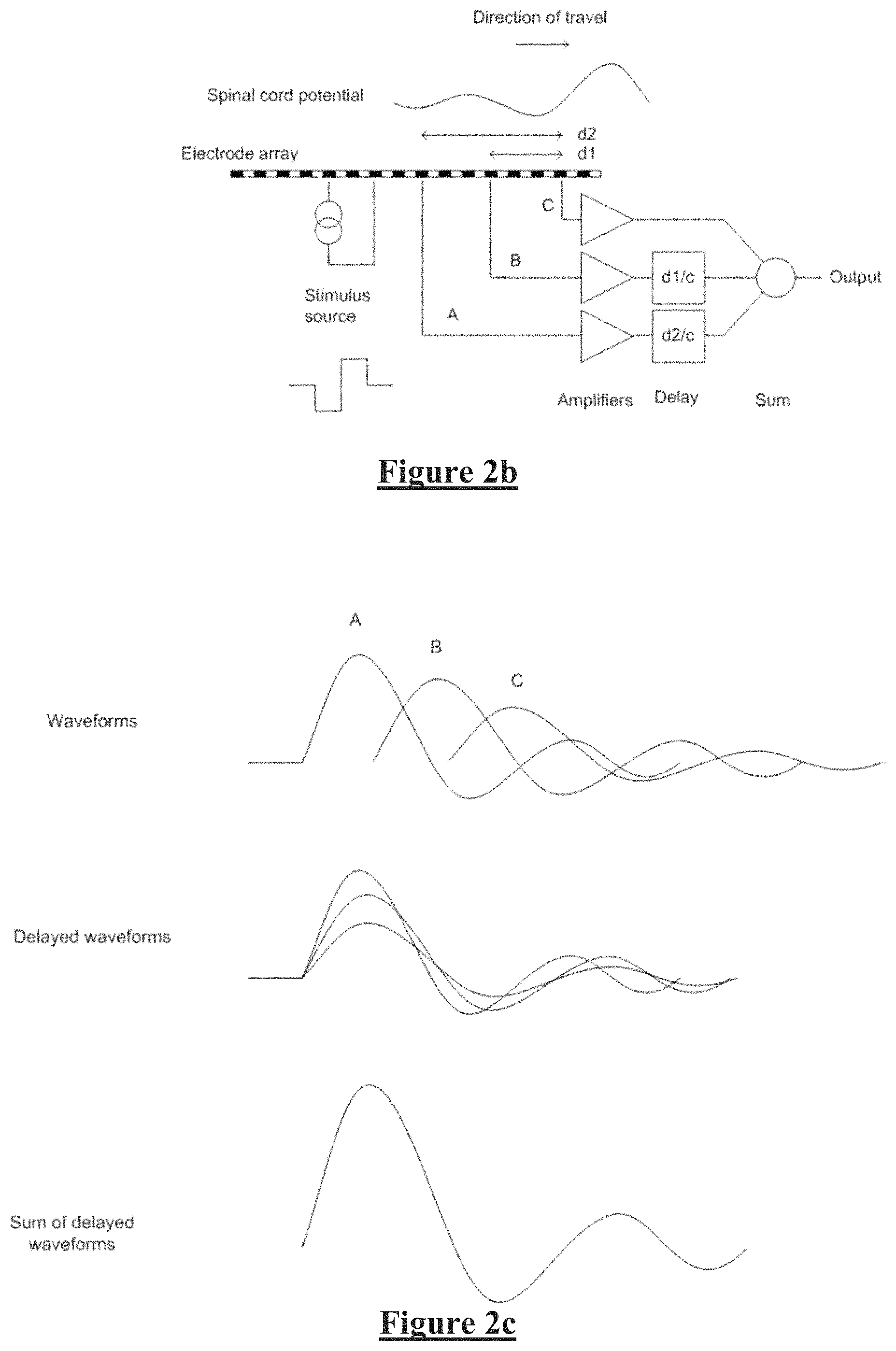
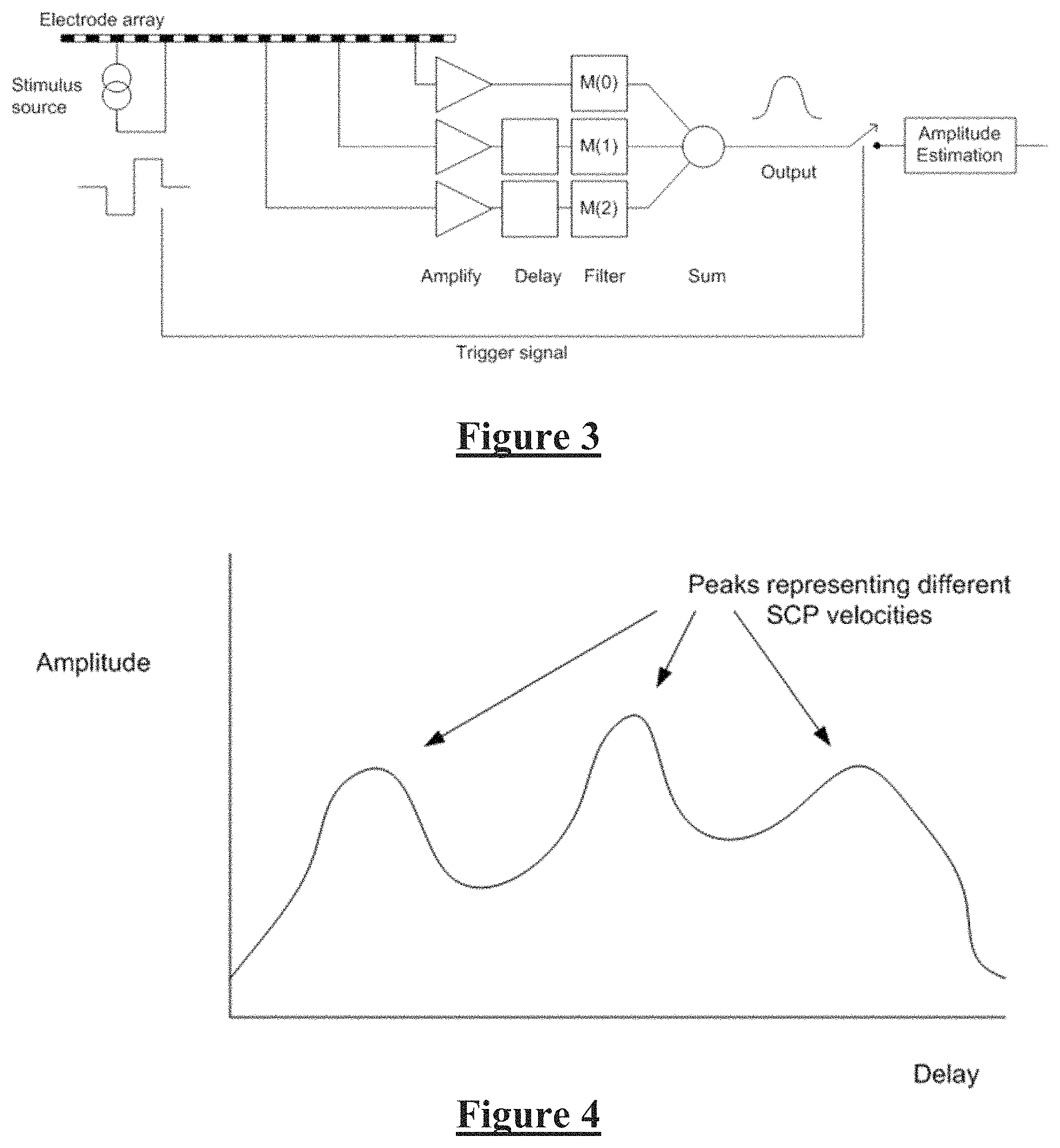

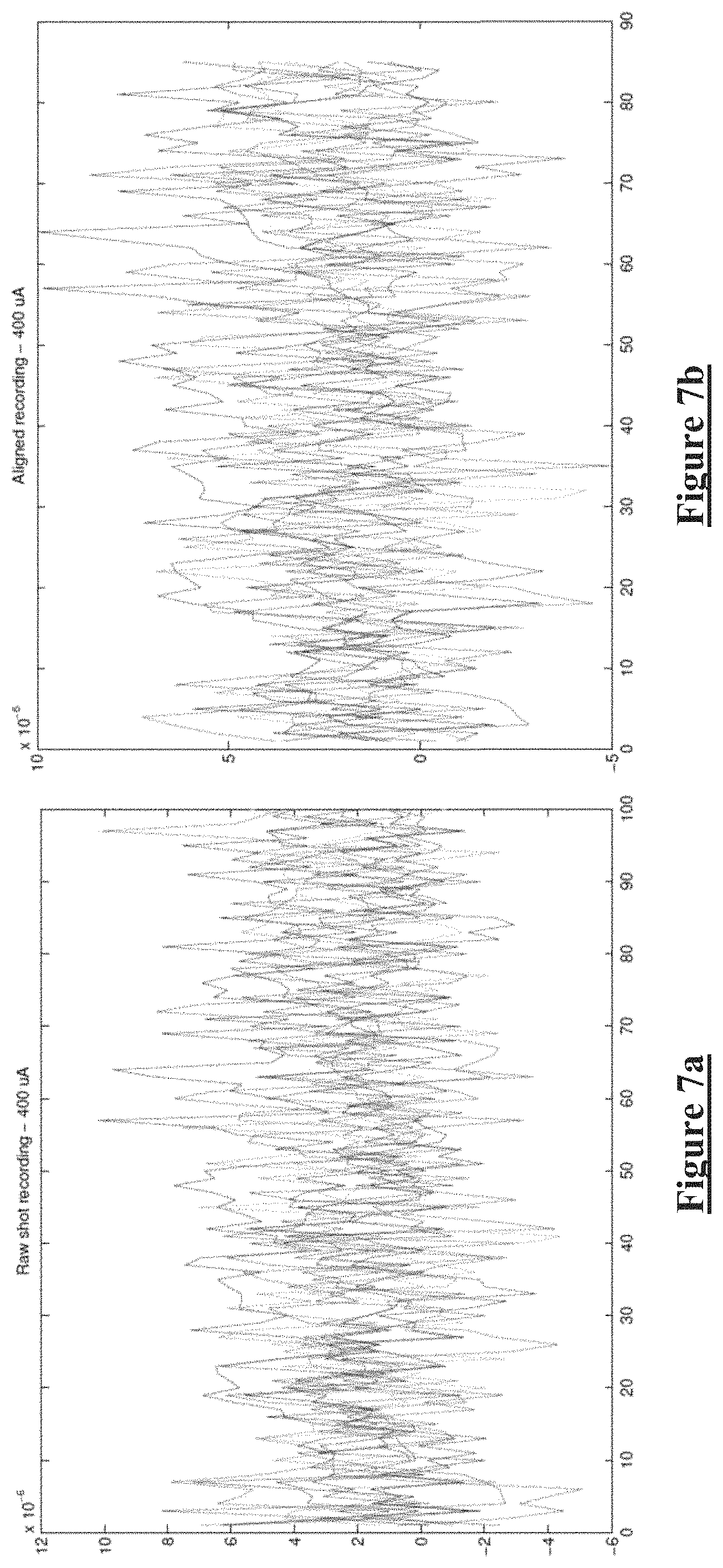

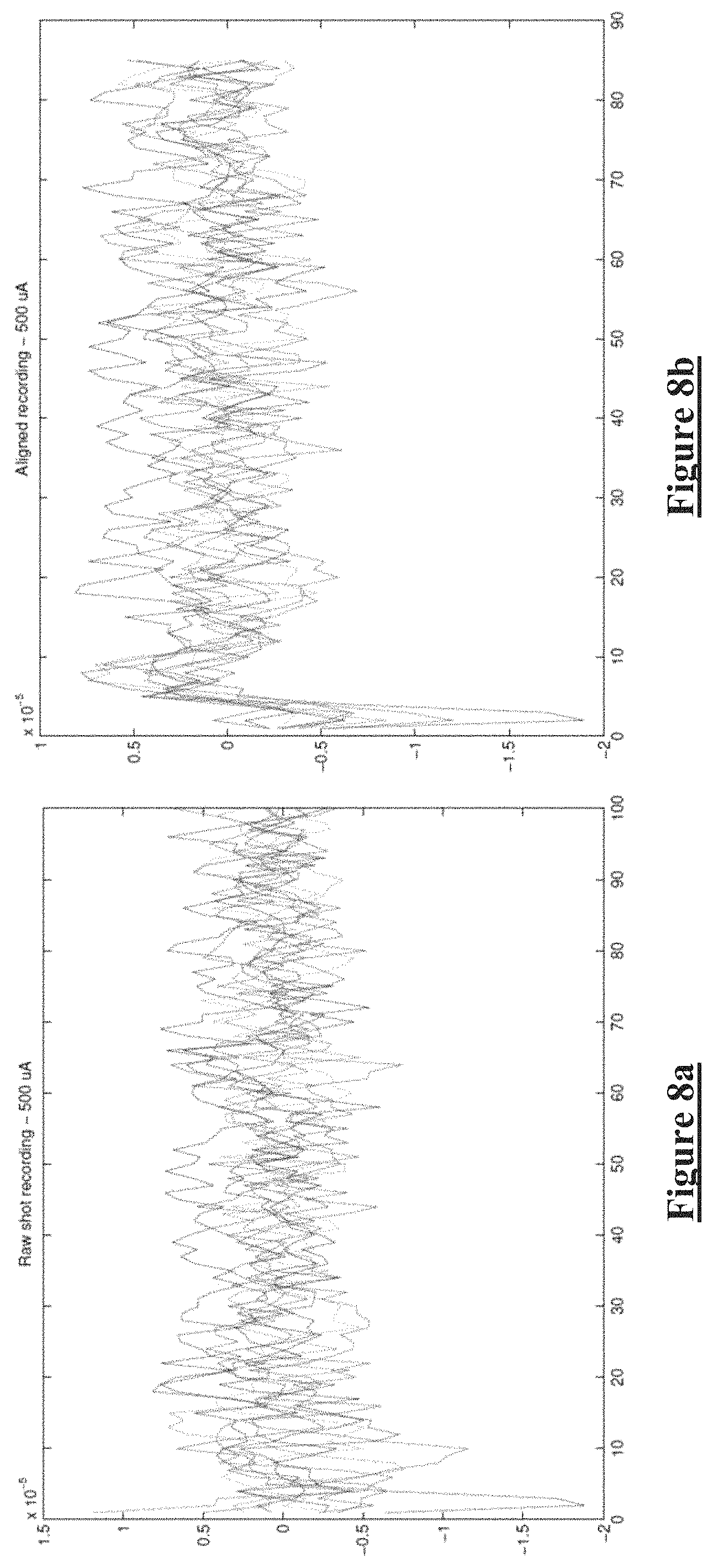

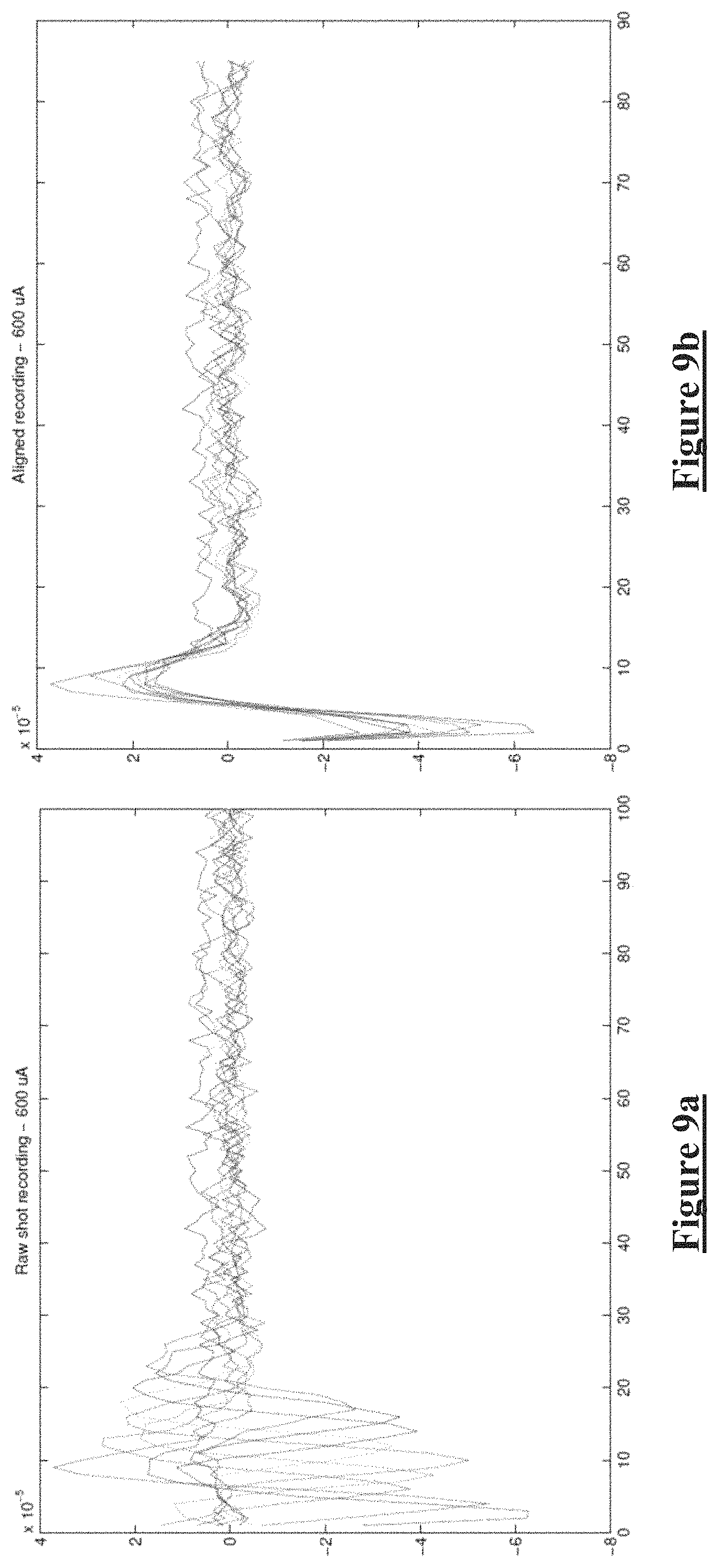
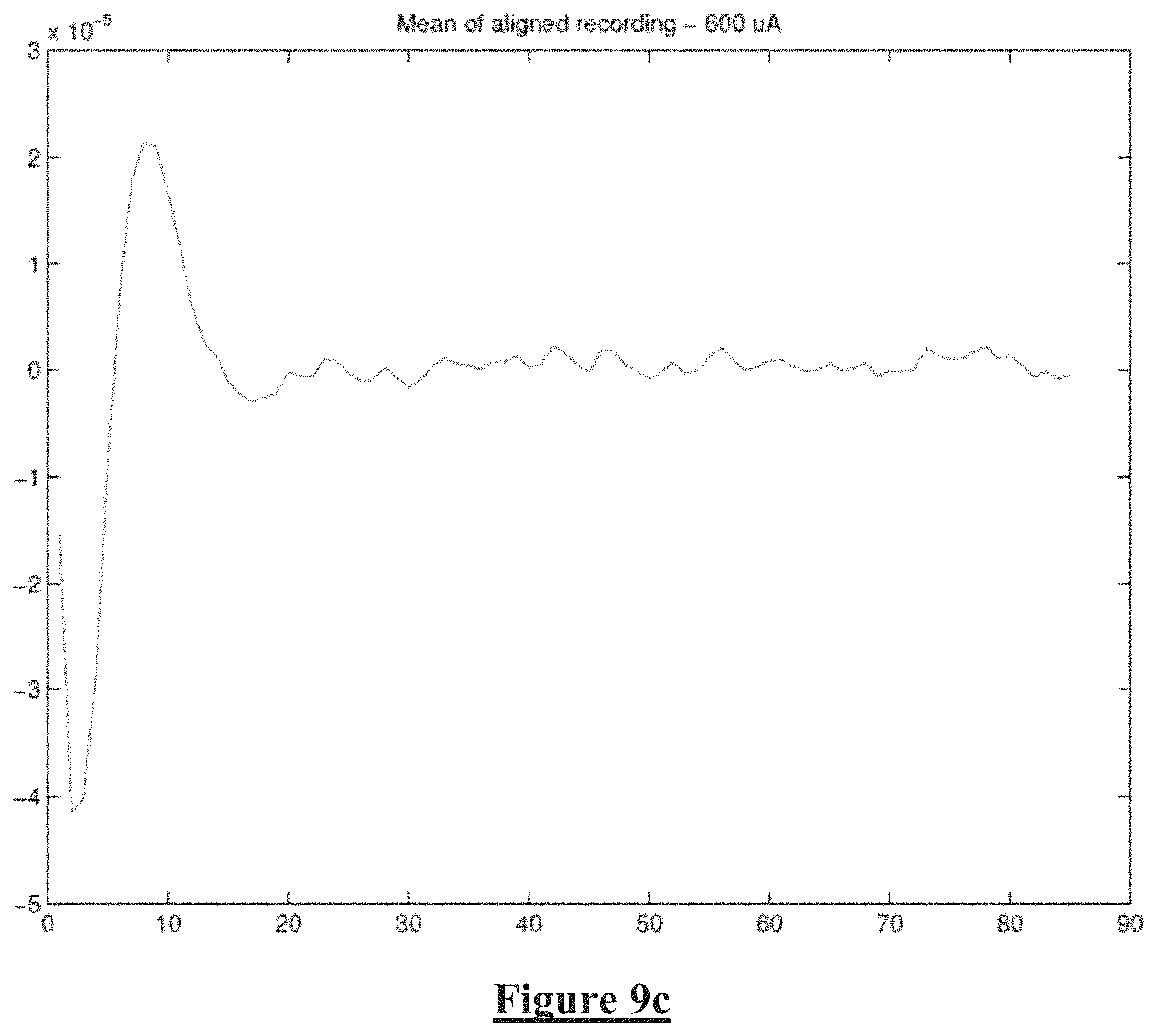
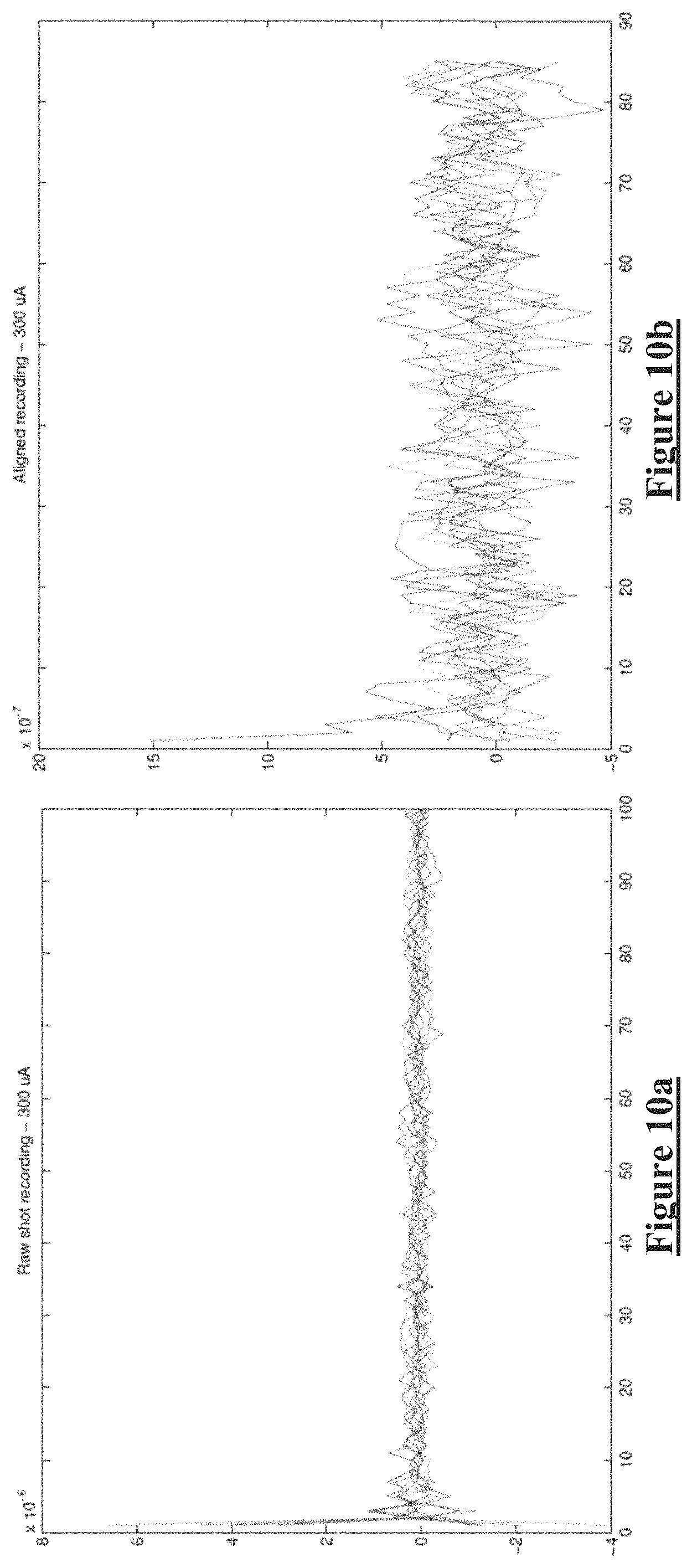
View All Diagrams
| United States Patent | 10,588,524 |
| Single , et al. | March 17, 2020 |
Method and apparatus for measurement of neural response
Abstract
A device for measuring a neural response evoked by a stimulus. First and second sense electrodes are positioned at distinct locations along a neural pathway. A neural stimulus is applied and first and second recordings of a neural response evoked by the stimulus are obtained from the respective sense electrodes. The first recording and the second recording are compared to determine propagation properties of the evoked neural response.
| Inventors: | Single; Peter Scott Vallack (Artarmon, AU), Laird; James Hamilton (Artarmon, AU) | ||||||||||
|---|---|---|---|---|---|---|---|---|---|---|---|
| Applicant: |
|
||||||||||
| Assignee: | Saluda Medical Pty Ltd
(Artarmon, AU) |
||||||||||
| Family ID: | 47176029 | ||||||||||
| Appl. No.: | 14/117,153 | ||||||||||
| Filed: | May 11, 2012 | ||||||||||
| PCT Filed: | May 11, 2012 | ||||||||||
| PCT No.: | PCT/AU2012/000518 | ||||||||||
| 371(c)(1),(2),(4) Date: | November 12, 2013 | ||||||||||
| PCT Pub. No.: | WO2012/155190 | ||||||||||
| PCT Pub. Date: | November 22, 2012 |
Prior Publication Data
| Document Identifier | Publication Date | |
|---|---|---|
| US 20140194772 A1 | Jul 10, 2014 | |
Foreign Application Priority Data
| May 13, 2011 [AU] | 2011901817 | |||
| May 13, 2011 [AU] | 2011901822 | |||
| May 13, 2011 [AU] | 2011901824 | |||
| Current U.S. Class: | 1/1 |
| Current CPC Class: | A61N 1/05 (20130101); A61B 5/4041 (20130101); A61B 5/04001 (20130101); A61N 1/0456 (20130101); A61B 5/40 (20130101); A61N 1/0551 (20130101); A61N 1/36071 (20130101); A61N 1/36135 (20130101) |
| Current International Class: | A61B 5/04 (20060101); A61N 1/05 (20060101); A61B 5/00 (20060101); A61N 1/04 (20060101); A61N 1/36 (20060101) |
References Cited [Referenced By]
U.S. Patent Documents
| 3736434 | May 1973 | Darrow |
| 3817254 | June 1974 | Maurer |
| 3898472 | August 1975 | Long |
| 4158196 | June 1979 | Crawford, Jr. |
| 4418695 | December 1983 | Buffet |
| 4474186 | October 1984 | Ledley et al. |
| 4628934 | December 1986 | Pohndorf et al. |
| 4807643 | February 1989 | Rosier |
| 4856525 | August 1989 | Van et al. |
| 5113859 | May 1992 | Funke |
| 5139020 | August 1992 | Koestner et al. |
| 5143081 | September 1992 | Young et al. |
| 5156154 | October 1992 | Valenta, Jr. et al. |
| 5172690 | December 1992 | Nappholz et al. |
| 5184615 | February 1993 | Nappholz et al. |
| 5188106 | February 1993 | Nappholz et al. |
| 5215100 | June 1993 | Spitz |
| 5324311 | June 1994 | Acken |
| 5417719 | May 1995 | Hull et al. |
| 5431693 | July 1995 | Schroeppel |
| 5458623 | October 1995 | Lu et al. |
| 5476486 | December 1995 | Lu et al. |
| 5497781 | March 1996 | Chen |
| 5638825 | June 1997 | Yamazaki et al. |
| 5702429 | December 1997 | King et al. |
| 5758651 | June 1998 | Nygard et al. |
| 5776170 | July 1998 | MacDonald et al. |
| 5785651 | July 1998 | Kuhn et al. |
| 5792212 | August 1998 | Weijand et al. |
| 5814092 | September 1998 | King |
| 5913882 | June 1999 | King |
| 5999848 | December 1999 | Gord et al. |
| 6020857 | February 2000 | Podger |
| 6027456 | February 2000 | Feler et al. |
| 6038480 | March 2000 | Hrdlicka et al. |
| 6066163 | May 2000 | John |
| 6114164 | September 2000 | Dennis et al. |
| 6144881 | November 2000 | Hemming et al. |
| 6157861 | December 2000 | Faltys et al. |
| 6212431 | April 2001 | Hahn et al. |
| 6246912 | June 2001 | Sluijter et al. |
| 6381496 | April 2002 | Meadows et al. |
| 6463328 | October 2002 | John |
| 6473649 | October 2002 | Gryzwa et al. |
| 6473653 | October 2002 | Schallhorn et al. |
| 6493576 | December 2002 | Dankwart-Eder |
| 6522932 | February 2003 | Kuzma |
| 6600955 | July 2003 | Zierhofer et al. |
| 6658293 | December 2003 | Vonk et al. |
| 6675046 | January 2004 | Holsheimer |
| 6782292 | August 2004 | Whitehurst |
| 6898582 | May 2005 | Lange et al. |
| 7089059 | August 2006 | Pless |
| 7171261 | January 2007 | Litvak et al. |
| 7231254 | June 2007 | DiLorenzo et al. |
| 7286876 | October 2007 | Yonce et al. |
| 7412287 | August 2008 | Yonce et al. |
| 7450992 | November 2008 | Cameron |
| 7734340 | June 2010 | De |
| 7742810 | June 2010 | Moffitt |
| 7792584 | September 2010 | Van et al. |
| 7818052 | October 2010 | Litvak et al. |
| 7831305 | November 2010 | Gliner |
| 7835804 | November 2010 | Fridman et al. |
| 8190251 | May 2012 | Molnar et al. |
| 8224459 | July 2012 | Pianca et al. |
| 8239031 | August 2012 | Fried et al. |
| 8359102 | January 2013 | Thacker et al. |
| 8494645 | July 2013 | Spitzer |
| 8588929 | November 2013 | Davis et al. |
| 8670830 | March 2014 | Carlson et al. |
| 8886323 | November 2014 | Wu et al. |
| 9155892 | October 2015 | Parker et al. |
| 9302112 | April 2016 | Bornzin et al. |
| 9381356 | July 2016 | Parker et al. |
| 9386934 | July 2016 | Parker et al. |
| 9974455 | May 2018 | Parker et al. |
| 10206596 | February 2019 | Single et al. |
| 10278600 | May 2019 | Parker et al. |
| 10368762 | August 2019 | Single |
| 2002/0055688 | May 2002 | Katims |
| 2002/0099419 | July 2002 | Ayal et al. |
| 2002/0193670 | December 2002 | Garfield |
| 2003/0032889 | February 2003 | Wells |
| 2003/0045909 | March 2003 | Gross et al. |
| 2003/0139781 | July 2003 | Bradley et al. |
| 2003/0195580 | October 2003 | Bradley et al. |
| 2004/0088017 | May 2004 | Sharma et al. |
| 2004/0122482 | June 2004 | Tung et al. |
| 2004/0158298 | August 2004 | Gliner |
| 2004/0225211 | November 2004 | Gozani et al. |
| 2004/0254494 | December 2004 | Spokoyny et al. |
| 2005/0010265 | January 2005 | Baru Fassio |
| 2005/0017190 | January 2005 | Eversmann et al. |
| 2005/0021104 | January 2005 | DiLorenzo |
| 2005/0065427 | March 2005 | Magill |
| 2005/0070982 | March 2005 | Heruth et al. |
| 2005/0075683 | April 2005 | Miesel et al. |
| 2005/0101878 | May 2005 | Daly |
| 2005/0113877 | May 2005 | Giardello et al. |
| 2005/0137670 | June 2005 | Christopherson et al. |
| 2005/0149154 | July 2005 | Cohen |
| 2005/0192567 | September 2005 | Katims |
| 2005/0203600 | September 2005 | Wallace |
| 2005/0209655 | September 2005 | Bradley et al. |
| 2005/0282149 | December 2005 | Kovacs et al. |
| 2006/0009820 | January 2006 | Royle et al. |
| 2006/0020291 | January 2006 | Gozani |
| 2006/0135998 | June 2006 | Libbus et al. |
| 2006/0195159 | August 2006 | Bradley et al. |
| 2006/0212089 | September 2006 | Tass |
| 2006/0217782 | September 2006 | Boveja et al. |
| 2006/0264752 | November 2006 | Rubinsky et al. |
| 2006/0287609 | December 2006 | Litvak et al. |
| 2007/0021800 | January 2007 | Bradley et al. |
| 2007/0073354 | March 2007 | Knudson et al. |
| 2007/0100378 | May 2007 | Maschino |
| 2007/0178579 | August 2007 | Ross et al. |
| 2007/0185409 | August 2007 | Wu et al. |
| 2007/0208394 | September 2007 | King et al. |
| 2007/0225767 | September 2007 | Daly |
| 2007/0244410 | October 2007 | Fridman |
| 2007/0250120 | October 2007 | Flach et al. |
| 2007/0255372 | November 2007 | Metzler et al. |
| 2007/0282217 | December 2007 | McGinnis et al. |
| 2007/0287931 | December 2007 | Dilorenzo |
| 2008/0021292 | January 2008 | Stypulkowski |
| 2008/0051647 | February 2008 | Wu et al. |
| 2008/0064947 | March 2008 | Heruth et al. |
| 2008/0077191 | March 2008 | Morrell |
| 2008/0097529 | April 2008 | Parramon et al. |
| 2008/0147155 | June 2008 | Swoyer |
| 2008/0183076 | July 2008 | Witte |
| 2008/0208304 | August 2008 | Zdravkovic et al. |
| 2008/0234780 | September 2008 | Smith et al. |
| 2008/0275527 | November 2008 | Greenberg et al. |
| 2008/0294221 | November 2008 | Kilgore |
| 2008/0300655 | December 2008 | Cholette |
| 2009/0033486 | February 2009 | Costantino et al. |
| 2009/0082691 | March 2009 | Denison |
| 2009/0157155 | June 2009 | Bradley |
| 2009/0270957 | October 2009 | Pianca |
| 2009/0287277 | November 2009 | Conn et al. |
| 2009/0299214 | December 2009 | Wu et al. |
| 2009/0306491 | December 2009 | Haggers |
| 2010/0010388 | January 2010 | Panken et al. |
| 2010/0058126 | March 2010 | Chang et al. |
| 2010/0069835 | March 2010 | Parker |
| 2010/0069996 | March 2010 | Strahl |
| 2010/0070007 | March 2010 | Parker |
| 2010/0070008 | March 2010 | Parker |
| 2010/0106231 | April 2010 | Torgerson |
| 2010/0114237 | May 2010 | Giftakis et al. |
| 2010/0114258 | May 2010 | Donofrio et al. |
| 2010/0125313 | May 2010 | Lee et al. |
| 2010/0125314 | May 2010 | Bradley et al. |
| 2010/0145222 | June 2010 | Brunnett et al. |
| 2010/0152808 | June 2010 | Boggs |
| 2010/0179626 | July 2010 | Pilarski |
| 2010/0191307 | July 2010 | Fang et al. |
| 2010/0204748 | August 2010 | Lozano et al. |
| 2010/0222844 | September 2010 | Troosters et al. |
| 2010/0222858 | September 2010 | Meloy |
| 2010/0249643 | September 2010 | Gozani |
| 2010/0249867 | September 2010 | Wanasek |
| 2010/0258342 | October 2010 | Parker |
| 2010/0262208 | October 2010 | Parker |
| 2010/0262214 | October 2010 | Robinson |
| 2010/0280570 | November 2010 | Sturm et al. |
| 2010/0286748 | November 2010 | Midani et al. |
| 2010/0331604 | December 2010 | Okamoto et al. |
| 2010/0331926 | December 2010 | Lee et al. |
| 2011/0004207 | January 2011 | Wallace et al. |
| 2011/0021943 | January 2011 | Lacour et al. |
| 2011/0028859 | February 2011 | Chian |
| 2011/0087085 | April 2011 | Tsampazis et al. |
| 2011/0093042 | April 2011 | Torgerson et al. |
| 2011/0106100 | May 2011 | Bischoff |
| 2011/0184488 | July 2011 | De et al. |
| 2011/0204811 | August 2011 | Pollmann-retsch |
| 2011/0224749 | September 2011 | Ben-David et al. |
| 2011/0264165 | October 2011 | Molnar et al. |
| 2011/0270343 | November 2011 | Buschman et al. |
| 2011/0307030 | December 2011 | John |
| 2011/0313310 | December 2011 | Tomita |
| 2011/0313483 | December 2011 | Hincapie et al. |
| 2012/0029377 | February 2012 | Polak |
| 2012/0101552 | April 2012 | Lazarewicz et al. |
| 2012/0109236 | May 2012 | Jacobson et al. |
| 2012/0253423 | October 2012 | Youn et al. |
| 2012/0277621 | November 2012 | Gerber et al. |
| 2012/0277823 | November 2012 | Gerber et al. |
| 2013/0053722 | February 2013 | Carlson et al. |
| 2013/0060302 | March 2013 | Polefko et al. |
| 2013/0172774 | July 2013 | Crowder et al. |
| 2013/0289661 | October 2013 | Griffith et al. |
| 2013/0289683 | October 2013 | Parker et al. |
| 2014/0066803 | March 2014 | Choi |
| 2014/0142447 | May 2014 | Takahashi et al. |
| 2014/0194771 | July 2014 | Parker et al. |
| 2014/0236042 | August 2014 | Parker et al. |
| 2014/0236257 | August 2014 | Parker et al. |
| 2014/0243926 | August 2014 | Carcieri |
| 2014/0243931 | August 2014 | Parker et al. |
| 2014/0276195 | September 2014 | Papay et al. |
| 2014/0277250 | September 2014 | Su et al. |
| 2014/0288551 | September 2014 | Bharmi et al. |
| 2014/0288577 | September 2014 | Robinson et al. |
| 2014/0296737 | October 2014 | Parker et al. |
| 2014/0358024 | December 2014 | Nelson et al. |
| 2015/0018699 | January 2015 | Zeng et al. |
| 2015/0164354 | June 2015 | Parker et al. |
| 2015/0174396 | June 2015 | Fisher et al. |
| 2015/0238104 | August 2015 | Tass |
| 2015/0238304 | August 2015 | Lamraoui |
| 2015/0282725 | October 2015 | Single |
| 2015/0313487 | November 2015 | Single |
| 2015/0360031 | December 2015 | Bornzin et al. |
| 2015/0374999 | December 2015 | Parker |
| 2016/0166164 | June 2016 | Obradovic et al. |
| 2016/0287126 | October 2016 | Parker et al. |
| 2016/0287182 | October 2016 | Single |
| 2017/0001017 | January 2017 | Parker et al. |
| 2017/0049345 | February 2017 | Single |
| 2017/0071490 | March 2017 | Parker et al. |
| 2017/0135624 | May 2017 | Parker |
| 2017/0216587 | August 2017 | Parker |
| 2018/0110987 | April 2018 | Parker |
| 2018/0117335 | May 2018 | Parker et al. |
| 2018/0132747 | May 2018 | Parker et al. |
| 2018/0132760 | May 2018 | Parker |
| 2018/0133459 | May 2018 | Parker et al. |
| 2018/0228391 | August 2018 | Parker et al. |
| 2018/0228547 | August 2018 | Parker |
| 2018/0229046 | August 2018 | Parker et al. |
| 2018/0256052 | September 2018 | Parker et al. |
| 2019/0168000 | June 2019 | Laird-wah |
| 2019/0216343 | July 2019 | Single et al. |
| 0219084 | Apr 1987 | EP | |||
| 0998958 | Aug 2005 | EP | |||
| 2019716 | Nov 2007 | EP | |||
| 2243510 | Oct 2010 | EP | |||
| 2443995 | Apr 2012 | EP | |||
| 2707095 | Mar 2014 | EP | |||
| 2012524629 | Oct 2012 | JP | |||
| 2013527784 | Jul 2013 | JP | |||
| 2013536044 | Sep 2013 | JP | |||
| 1983003191 | Sep 1983 | WO | |||
| 1993001863 | Feb 1993 | WO | |||
| 9612383 | Apr 1996 | WO | |||
| 2000002623 | Jan 2000 | WO | |||
| 2002036003 | Nov 2001 | WO | |||
| 2002038031 | May 2002 | WO | |||
| 2002049500 | Jun 2002 | WO | |||
| 2003028521 | Apr 2003 | WO | |||
| 2003043690 | May 2003 | WO | |||
| 2003103484 | Dec 2003 | WO | |||
| 2004021885 | Mar 2004 | WO | |||
| 2004103455 | Dec 2004 | WO | |||
| 2005032656 | Apr 2005 | WO | |||
| 2005105202 | Nov 2005 | WO | |||
| 2006091636 | Aug 2006 | WO | |||
| 2007064936 | Jun 2007 | WO | |||
| 2007127926 | Nov 2007 | WO | |||
| 2007130170 | Nov 2007 | WO | |||
| 2008004204 | Jan 2008 | WO | |||
| 2008049199 | May 2008 | WO | |||
| 2009002072 | Dec 2008 | WO | |||
| 2009002579 | Dec 2008 | WO | |||
| 2009010870 | Jan 2009 | WO | |||
| 2009130515 | Oct 2009 | WO | |||
| WO 2009130515 | Oct 2009 | WO | |||
| 2009146427 | Dec 2009 | WO | |||
| 2010013170 | Feb 2010 | WO | |||
| 2010044989 | Apr 2010 | WO | |||
| 2010051392 | May 2010 | WO | |||
| 2010057046 | May 2010 | WO | |||
| 2010124139 | Oct 2010 | WO | |||
| 2010138915 | Dec 2010 | WO | |||
| 2011011327 | Jan 2011 | WO | |||
| 2011066477 | Jun 2011 | WO | |||
| 2011066478 | Jun 2011 | WO | |||
| 2011112843 | Sep 2011 | WO | |||
| 2011119251 | Sep 2011 | WO | |||
| 2011159545 | Dec 2011 | WO | |||
| 2012027252 | Mar 2012 | WO | |||
| 2012027791 | Mar 2012 | WO | |||
| 2012155183 | Nov 2012 | WO | |||
| 2012155184 | Nov 2012 | WO | |||
| 2012155185 | Nov 2012 | WO | |||
| 2012155187 | Nov 2012 | WO | |||
| 2012155188 | Nov 2012 | WO | |||
| 2012155189 | Nov 2012 | WO | |||
| 2012155190 | Nov 2012 | WO | |||
| 2013063111 | May 2013 | WO | |||
| 2013075171 | May 2013 | WO | |||
| 2014071445 | May 2014 | WO | |||
| 2014071446 | May 2014 | WO | |||
| 2014143577 | Sep 2014 | WO | |||
| 2015070281 | May 2015 | WO | |||
| 2015074121 | May 2015 | WO | |||
| 2015109239 | Jul 2015 | WO | |||
| 2015143509 | Oct 2015 | WO | |||
| 2015168735 | Nov 2015 | WO | |||
| 2016011512 | Jan 2016 | WO | |||
| 2016077882 | May 2016 | WO | |||
| 2016090420 | Jun 2016 | WO | |||
| 2016090436 | Jun 2016 | WO | |||
| 2016115596 | Jul 2016 | WO | |||
| 2016161484 | Oct 2016 | WO | |||
| 2016191807 | Dec 2016 | WO | |||
| 2016191808 | Dec 2016 | WO | |||
| 2016191815 | Dec 2016 | WO | |||
| 2017173493 | Oct 2017 | WO | |||
| 2017219096 | Dec 2017 | WO | |||
Other References
|
Fagius et al. (Sympathetic Reflex Latencies and Conduction Velocities in Normal Man; 1980). cited by examiner . Extended European Search Report for EP Application 12785483.4, completed Sep 16, 2014, 7 pgs. cited by applicant . Kent et al., "Instrumentation to Record Evoked Potentials for Closed-Loop Control of Deep Brain Stimulation", Conf. Proc. IEEE Eng. Med Biol. Sol, Aug. 2012, 10 pgs. cited by applicant . European Search Report for European Application 12785619.3, Search Completed Oct. 13, 2014, dated Oct. 23, 2014, 7 pgs. cited by applicant . International Search Report for International Application No. PCT/AU2012/000511, International Filing Date May 11, 2012, Search Completed May 17, 2012, dated May 18, 2012, 4 pgs. cited by applicant . International Search Report for International Application No. PCT/AU2012/000512, International Filing Date May 11, 2012, Search Completed Jul. 10, 2012, dated Jul. 11, 2012, 4 pgs. cited by applicant . International Search Report for International Application No. PCT/AU2012/000513, International Filing Date May 11, 2012, Search Completed May 29, 2012, dated May 30, 2012, 5 pgs. cited by applicant . International Search Report for International Application No. PCT/AU2012/000515, International Filing Date May 11, 2012, Search Completed May 21, 2012, dated Jun. 4, 2012, 5 pgs. cited by applicant . International Search Report for International Application No. PCT/AU2012/000516, International Filing Date May 11, 2012, Search Completed Jul. 11, 2012, dated Jul. 12, 2012, 8 pgs. cited by applicant . International Search Report for International Application No. PCT/AU2012/000517, International Filing Date May 11, 2012, Search Completed Jun. 4, 2012, dated Jun. 6, 2012, 3 pgs. cited by applicant . International Search Report for International Application No. PCT/AU2012/000518, International Filing Date May 11, 2012, Search Completed Jun. 8, 2012, dated Jun. 12, 2012, 4 pgs. cited by applicant . Written Opinion for International Application No. PCT/AU2012/000511, International Filing Date May 11, 2012, Search Completed May 17, 2012, dated May 18, 2012, 5 pgs. cited by applicant . Written Opinion for International Application No. PCT/AU2012/000512, International Filing Date May 11, 2012, Search Completed Jul. 10, 2012, dated Jul. 11, 2012, 7 pgs. cited by applicant . Written Opinion for International Application No. PCT/AU2012/000513, International Filing Date May 11, 2012, Search Completed May 29, 2012, dated May 30, 2012, 7 pgs. cited by applicant . Written Opinion for International Application No. PCT/AU2012/000515, International Filing Date May 11, 2012, Search Completed May 21, 2012, dated Jun. 4, 2012, 4 pgs. cited by applicant . Written Opinion for International Application No. PCT/AU2012/000516, International Filing Date May 11, 2012, Search Completed Jul. 11, 2012, dated Jul. 12, 2012, 8 pgs. cited by applicant . Written Opinion for International Application No. PCT/AU2012/000517, International Filing Date May 11, 2012, Search Completed Jun. 4, 2012, dated Jun. 6, 2012, 5 pgs. cited by applicant . Written Opinion for International Application No. PCT/AU2012/000518, International Filing Date May 11, 2012, Search Completed Jun. 8, 2012, dated Jun. 12, 2012, 10 pgs. cited by applicant . European Search Report for European Application 12785669.8, Search Completed Sep. 22, 2014, dated Sep. 29, 2014, 5 pgs. cited by applicant . International Search Report for Australian Application 2011901829, Search Completed Feb. 6, 2012, dated Feb. 7, 2012, 3pgs. cited by applicant . Andreassen, S. et al., "Muscle Fibre Conduction Velocity in Motor Units of the Human Anterior Tibial Muscle: a New Size Principle Parameter", J. Physiol. (1987), 391, pp. 561-571. cited by applicant . Blum, A. R., "An Electronic System for Extracelluar Neural Stimulation and Recording", Dissertation, Georgia Institute of Technology, Aug. 2007, Retrieved from http://smartech.gatech.edu/handle/1853/16192 on Jan. 30, 2012. cited by applicant . Dawson, G. D., "The relative excitability and conduction velocity of sensory and motor nerve fibres in man", Journal of Physiology, 1956, vol. 131(2), pp. 436-451. Figs. 1-5; Table 1; p. 437 "Methods"; pp. 438-447 "Results." cited by applicant . Dijkstra, E. A., "Ultrasonic Distance Detection for a Closed-Loop Spinal Cord Stimulation System", Proceedings--19th International Conference--IEEE/EMBS Oct. 30-Nov. 2, 1997, Chicago, IL. p. 324 section `Paraesthesia Coverage by Dermatome,` p. 326 section `Total Paraesthesia Coverage` and Figures 1 and 6-10. cited by applicant . Dillier, N et al., "Measurement of the electrically evoked compound action potential via a neural response telemetry system", Ann. Otol. Rhinol. Laryngol. 111 (May 2002), No. 5, pp. 407-414. Abstract & Figures 2-3, 407-414. cited by applicant . Fagius, J. et al., "Sympathetic Reflex Latencies and Conduction Velocities in Normal Man", Journal of Neurological Sciences, 1980. vol. 47, pp. 433-448. cited by applicant . Goodall, E. V., "Modeling Study of Activation and Propagation delays During Stimulation of Peripheral Nerve Fibres with a Tripolar Cuff Electrode", IEEE Trans.Rehab.Eng. V. 3, pp. 272-282. cited by applicant . Harper, A. A., "Conduction Velocity is Related to Morphological Cell Type in Rat Dorsal Root Ganglion Neurones", J. Physiol. (1985), 359, pp. 31-46. cited by applicant . Mahnam, A et al., "Measurement of the current-distance relationship using a novel refractory interaction technique", J. Neural Eng. 6 (2009), pp. 036005 (published May 20, 2009) Abstract, Sec. 2.2 & Figure 2b, 036005. cited by applicant . Massachusetts Institute of Techn, "The Compound Action Potential of the Frog Sciatic Nerve", Quantitative Physiology: Cells and Tissues. Fall, 1999, Retrieved from http://umech.mit.edu/freeman/6.021J/2001/lab.pdf on May 22, 2012. cited by applicant . Mcgill, Kevin et al., "On the Nature and Elimination of Stimulus Artifact in Nerve Signals Evoked and Recorded Using Surface Electrodes", IEEE Transactions on Biomedical Engineering, vol. BME-29, No. 2, Feb. 1982, pp. 129-137. cited by applicant . Opsommer, E. et al., "Determination of Nerve Conduction Velocity of C-fibres in Humans from Thermal Thresholds to Contact Heat (Thermode) and from Evoked Brain Potentials to Radiant Heat (CO2 Laser)", Neurophysiologie Clinique 1999, vol. 29, pp. 411-422. cited by applicant . Parker, J. L., "Compound Action Potentials Recorded in the Human Spinal Cord During Neurostimulation for Pain Relief", Pain, vol. 153, 2012, pp. 593-601. cited by applicant . Roy, S. H., "Effects of Electrode Location on Myoelectric Conduction Velocity and Median Frequency Estimates", J. Appl. Physiol. 61 (4), 1986, pp. 1510-1517. cited by applicant . Tomas et al., "Dorsal Root Entry Zone (DREZ) Localization Using Direct Spinal Cord Stimulation Can Improve Results of the DREZ Thermocoagulation Procedure for Intractable Pain Relief", Pain, 2005, vol. 116, pp. 159-163. cited by applicant . Yearwood, T. L., "Pulse Width Programming in Spinal Cord Stimulation: a Clinical Study", Pain Physician. 2010. vol. 13, pp. 321-335. cited by applicant . Borg et al., "Conduction velocity and refractory period of single motor nerve fibres in antecedent poliomyelitis", Journal of Neurology, Neurosurgery, and Psychiatry, vol. 50, 1987, 443-446. cited by applicant . Orstavik, Kristin et al., "Pathological C-fibres in patients with a chronic painful condition", Brain (2003), 126, 567-578. cited by applicant . Yuan, S. et al., "Recording monophasic action potentials using a platinum-electrode ablation catheter", Europace. Oct. 2000; 2(4):312-9; Abstract. cited by applicant . Extended European Search Report for European Application No. 11820923.8, report completed Dec. 9, 2013, report dated Dec. 17, 2013, 6 pgs. cited by applicant . Extended European Search Report for European Application No. 13852669.4, Search completed Jun. 8, 2016, dated Jun. 22, 2016, 09 Pgs. cited by applicant . Extended European Search Report for European Application No. 14861553.7, Search completed Jun. 8, 2017, dated Jun. 19, 2017, 8 Pgs. cited by applicant . Extended European Search Report for European Application No. 14863597.2, Search completed Jun. 6, 2017, dated Jun. 13, 2017, 9 Pgs. cited by applicant . Extended European Search Report for European Application No. 13853514.1, Search completed Jun. 8, 2016, dated Jun. 15, 2016, 07 Pgs. cited by applicant . Extended European Search Report for European Application No. 15768956.3, Search completed Oct. 3, 2017, dated Oct. 10, 2017, 8 Pgs. cited by applicant . Kumar et al., "Double-blind evaluation of subthalamic nucleus deep brain stimulation in advanced Parkinson's disease", by the American Academy of Neurology, 51, No. 3, Sep. 1, 1998, pp. 850-855. cited by applicant . Kumar et al., "Globus Pallidus Deep Brain Stimulation for Generalized Dystonia: Clinical and PET Investigation", Neurology, 53, No. 4, 1999, pp. 871-874. cited by applicant . Laird et al., "A Model of Evoked Potentials in Spinal Cord Stimulation", IEEE Engineering in Medicine & Biology Society, 35th Annual Conference. Osaka, Japan: Jul. 3-7, 2013, pp. 6555-6558. cited by applicant . Lempka, Scott, "The Electrode-Tissue Interface During Recording and Stimulation in the Central Nervous System", published on May 2010. cited by applicant . Levy et al., "Incidence and Avoidance of Neurologic Complications with Paddle Type Spinal Cord Stimulation Leads", Neuromodulation 14(15), Sep. 2011, pp. 412-422. cited by applicant . Li et al., S., "Resonant antidromic cortical circuit activation as a consequence of high-frequency subthalamic deep-brain stimulation", J Neurophysiol. Dec. 2007; 98(6): 3525-37. First published Oct. 10, 2007. doi:10.1152/jn.00808.2007. cited by applicant . Ma et al., "Similar Electrophysiological Changes in Axotomized and Neighboring Intact Dorsal Root Ganglion Neurons", Journal of Neurophysiology 89, No. 3 (Mar. 1, 2003): 1588-1602, doi:10.1152/jn.00855.2002. cited by applicant . Macefield, "Spontaneous and Evoked Ectopic Discharges Recorded from Single Human Axons", Muscle & Nerve 21, No. 4, Apr. 1998, pp. 461-468. cited by applicant . Markandey, Vishal, "ECG Implementation on the TMS320C5515 DSP Medical Development Kit (MDK)", Texas Instruments Application Report Jun. 2010, 35 pgs. cited by applicant . Matzner et al., "Na+ Conductance and the Threshold for Repetitive Neuronal Firing", Brain Research 597, No. 1 (Nov. 27, 1992): 92-98, doi:10.1016/0006-8993(92)91509-D. cited by applicant . Melzack et al., "Pain mechanisms: a new theory", Science, New York, New York, vol. 150, No. 3699, Nov. 19, 1965, pp. 971-979. cited by applicant . Miles et al., "An Electrode for Prolonged Stimulation of the Brain", Proc. 8th Meeting World Soc. Stereotactic and Functional Neurosurgery, Part III, Zurich, 1981, Appl. Neurophysiol, 45, 1982, pp. 449-445. cited by applicant . Misawa et al., "Neuropathic Pain is Associated with Increased Nodal Persistent Na(+) Currents in Human Diabetic Neuropathy", Journal of the Peripheral Nervous System: JPNS, 14, No. 4 (Dec. 2009): 279-284. cited by applicant . Nordin et al., "Ectopic Sensory Discharges and Paresthesiae in Patients with Disorders of Peripheral Nerves, Dorsal Roots and Dorsal Columns", Pain 20, No. 3 (Nov. 1984): 231-245, doi:10.1016/0304-3959(84)90013-7. cited by applicant . Oakley et al., "Spinal Cord Stimulation: Mechanisms of Action", Spine 27, No. 22, Nov. 15, 2002, pp. 2574-2583. cited by applicant . Oakley et al., "Transverse Tripolar Spinal Cord Stimulation: Results of an International Multicenter Study", Neuromodulation, vol. 9, No. 3, 2006, pp. 192-203. cited by applicant . Obradovic et al., "Effect of pressure on the spinal cord during spinal cord stimulation in an animal model", Poster, 18th Annual Meeting of the North American Neuromodulation Society, Dec. 11-14, 2014, Las Vegas. cited by applicant . Oh et al., "Long-term hardware-related complications of deep brain stimulation", Neurosurgery, vol. 50, No. 6, Jun. 2002, pp. 1268-1274, discussion pp. 1274-1276. cited by applicant . Ouyang et al., "Compression Induces Acute Demyelination and Potassium Channel Exposure in Spinal Cord", Journal of Neurotrauma 27, No. 6, Jun. 2010, 1109-1120, doi:10.1089/neu.2010.1271. cited by applicant . Parker et al., "Closing the Loop in Neuromodulation Therapies: Spinal Cord Evoked Compound Action Potentials During Stimulation for Pain Management (230).", 2011, In 15th Annual Meeting, North American Neuromodulation Society (p. 48). Presented at the North American Neuromodulation Society, Las Vegas. cited by applicant . Parker et al., "Compound action potentials recorded in the human spinal cord during neurostimulation for pain relief", Pain, 2012, vol. 153, pp. 593-601. cited by applicant . Parker et al., "Electrically Evoked Compound Action Potentials Recorded From the Sheep Spinal Cord", Neuromodulation, vol. 16, 2013, pp. 295-303. cited by applicant . Penar et al., "Cortical Evoked Potentials Used for Placement of a Laminotomy Lead Array: A Case Report", Neuromodulation: Technology at the Neural Interface, accessed Apr. 19, 2011, doi:10.1111/j.1525-1403.2011.00352.x. cited by applicant . Richter et al., "EMG and SSEP Monitoring During Cervical Spinal Cord Stimulation", Journal of Neurosurgical Review 2011, Southern Academic Press, 1(S1), 2011, pp. 61-63. cited by applicant . Ridder et al., "Burst Spinal Cord Stimulation for Limb and Back Pain", World Neurosurgery, 2013, 9 pgs. cited by applicant . Ridder et al., "Burst Spinal Cord Stimulation toward Paresthesia-Free Pain Suppression", May 2010, vol. 66, pp. 986-990. cited by applicant . Schmidt et al., "Gating of tactile input from the hand", Exp Brain Res, 1990, 79, pp. 97-102. cited by applicant . Siegfried et al., "Bilateral Chronic Electrostimulation of Ventroposterolateral Pallidum: A New Therapeutic Approach for Alleviating all Parkinsonian Symptoms", Neurosurgery, 35, No. 6, Dec. 1994, pp. 1126-1130. cited by applicant . Siegfried et al., "Intracerebral Electrode Implantation System", Journal of Neurosurgery, vol. 59, No. 2, Aug. 1983, pp. 356-3591. cited by applicant . Srinivasan, S., "Electrode/Electrolyte Interfaces: Structure and Kinetics of Charge Transfer", Fuel Cells, 2006, Chapter 2, 67 Pages. cited by applicant . Struijk et al, "Paresthesia Thresholds in Spinal Cord Stimulation: A Comparison of Theoretical Results with Clinical Data", IEEE Transactions on Rehabilitation Engineering, vol. 1, No. 2, Jun. 1993, pp. 101-108. cited by applicant . Sufka et al., "Gate Control Theory Reconsidered", Brain and Mind, 3, No. 2, 2002, pp. 277-290. cited by applicant . Tamura et al., "Increased Nodal Persistent Na+ Currents in Human Neuropathy and Motor Neuron Disease Estimated by Latent Addition", Clinical Neurophysiology 117, No. 11 (Nov. 2006): 2451-2458, doi:10.1016/j.clinph.2006.07.309. cited by applicant . Tasker, "Deep Brain Stimulation is Preferable to Thalamotomy for Tremor Suppression", Surgical Neurology, 49, No. 2, 1998, pp. 145-153. cited by applicant . Taylor et al., "Spinal Cord Stimulation for Chronic Back and Leg Pain and Failed Back Surgery Syndrome: A Systematic Review and Analysis of Prognostic Factors", SPINE, vol. 30, No. 1, 2004, pp. 152-160. cited by applicant . Texas Instruments, "Precision, Low Power Instrumentation Amplifiers", Texas Instruments SBOS051B Oct. 1995, Revised Feb. 2005, 20 pgs. cited by applicant . Tscherter et al., "Spatiotemporal Characterization of Rhythmic Activity in Rat Spinal Cord Slice Cultures", European Journal of Neuroscience 14, No. 2 (2001), pp. 179-190. cited by applicant . Van Den Berg et al., "Nerve fiber size-related block of action currents by phenytoin in mammalian nerve", Epilepsia, Nov. 1994, 35(6), pp. 1279-1288. cited by applicant . Villavicencio, Alan T. "Laminectomy versus Percutaneous Electrode Placement for Spinal Cord Stimulation," Neurosurgery, vol. 46 (2), Feb. 2000, pp. 399-405. cited by applicant . Vleggeert et al., Lankamp, "Electrophysiology and morphometry of the Aalpha- and Abeta-fiber populations in the normal and regenerating rat sciatic nerve", Experimental Neurology, vol. 187, No. 2, Jun. 1, 2004, Available online Apr. 2, 2004, pp. 337-349. cited by applicant . Woessner, "Blocking Out the Pain, Electric Nerve Block Treatments for Sciatic Neuritis", Retrieved from: http://www.practicalpainmanagement.com/pain/spine/radiculopathy/blocking-- out-pain, Last updated Jan. 10, 2012. cited by applicant . Wolter et al., "Effects of sub-perception threshold spinal cord stimulation in neuropathic pain: a randomized controlled double-blind crossover study", European Federation of International Association for the Study of Pain Chapters, 2012, pp. 648-655. cited by applicant . Wu et al., "Changes in A.beta. Non-nociceptive Primary Sensory Neurons in a Rat Model of Osteoarthritis Pain", Molecular Pain 6, No. 1 (Jul. 1, 2010): 37, doi:10.1186/1744-8069-6-37. cited by applicant . Xie et al., "Functional Changes in Dorsal Root Ganglion Cells after Chronic Nerve Constriction in the Rat", Journal of Neurophysiology 73, No. 5 (May 1, 1995): 1811-1820. cited by applicant . Xie et al., "Sinusoidal Time-Frequency Wavelet Family and its Application in Electrograstrographic Signal Analysis", Proceedings of the 20th Annual International Conference of the IEEE Engineering in Medicine and Biology Society, vol. 20, No. 3, Oct. 29, 1998, pp. 1450-1453. cited by applicant . Yingling et al., "Use of Antidromic Evoked Potentials in Placement of Dorsal Cord Disc Electrodes", Applied Neurophysiology, 1986, vol. 49, pp. 36-41. cited by applicant . International Preliminary Report on Patentability for International Application No. PCT/AU2011/001127, Report dated Mar. 5, 2013, 9 pgs. cited by applicant . International Preliminary Report on Patentability for International Application No. PCT/AU2012/000511, Report dated Nov. 19, 2013, 6 pgs. cited by applicant . International Preliminary Report on Patentability for International Application No. PCT/AU2012/000512, Report dated Nov. 19, 2013, 8 pgs. cited by applicant . International Preliminary Report on Patentability for International Application No. PCT/AU2012/000513, Report dated Nov. 19, 2013, 11 pgs. cited by applicant . International Preliminary Report on Patentability for International Application No. PCT/AU2012/000515, Report dated Nov. 19, 2013, 5 pgs. cited by applicant . International Preliminary Report on Patentability for International Application No. PCT/AU2012/000516, Report dated Nov. 19, 2013, 9 pgs. cited by applicant . International Preliminary Report on Patentability for International Application No. PCT/AU2012/000517, Report dated Nov. 19, 2013, 6 pgs. cited by applicant . International Preliminary Report on Patentability for International Application No. PCT/AU2012/000518, Report dated Nov. 19, 2013, 11 pgs. cited by applicant . International Preliminary Report on Patentability for International Application No. PCT/AU2013/001279, Report dated May 12, 2015, 6 pgs. cited by applicant . International Preliminary Report on Patentability for International Application No. PCT/AU2013/001280, Report dated May 12, 2015, 6 pgs. cited by applicant . International Preliminary Report on Patentability for International Application No. PCT/AU2014/001049, Report dated May 17, 2016, 5 pgs. cited by applicant . International Preliminary Report on Patentability for International Application No. PCT/AU2014/050369, Report dated May 24, 2016, 8 pgs. cited by applicant . International Preliminary Report on Patentability for International Application No. PCT/AU2015/050135, Report dated Oct. 4, 2016, 13 pgs. cited by applicant . International Preliminary Report on Patentability for International Application No. PCT/AU2015/050215, Report dated Nov. 8, 2016, 4 pgs. cited by applicant . International Preliminary Report on Patentability for International Application No. PCT/AU2015/050422, Report dated Jan. 31, 2017, 8 pgs. cited by applicant . International Preliminary Report on Patentability for International Application No. PCT/AU2015/050724, Report dated May 23, 2017, 5 pgs. cited by applicant . International Preliminary Report on Patentability for International Application No. PCT/AU2015/050753, Report dated Jun. 13, 2017, 7 pgs. cited by applicant . International Preliminary Report on Patentability for International Application No. PCT/AU2015/050787, Report dated Jun. 13, 2017, 6 pgs. cited by applicant . International Preliminary Report on Patentability for International Application No. PCT/AU2016/050019, Report dated Jul. 25, 2017, 9 pgs. cited by applicant . International Preliminary Report on Patentability for International Application No. PCT/AU2016/050263, Report dated Oct. 10, 2017, 9 pgs. cited by applicant . International Search Report and Written Opinion for International Application No. PCT/AU2016/050263, Search completed Nov. 16, 2016, dated Nov. 16, 2016, 8 Pgs. cited by applicant . International Search Report and Written Opinion for International Application No. PCT/AU2016/050430, Search completed Aug. 16, 2016, dated Aug. 16, 2016, 10 Pgs. cited by applicant . International Search Report and Written Opinion for International Application No. PCT/AU2016/050431, Search completed Aug. 16, 2016, dated Aug. 16, 2016, 11 Pgs. cited by applicant . International Search Report and Written Opinion for International Application No. PCT/AU2016/050439, Search completed Jul. 15, 2016, dated Jul. 15, 2016, 8 Pgs. cited by applicant . Alam et al., "Evaluation of optimal electrode configurations for epidural spinal cord stimulation in cervical spinal cord injured rats", Journal of Neuroscience Methods, Mar. 2015, 28 pgs. cited by applicant . Fisher, "F-Waves--Physiology and Clinical Uses", TheScientificWorldJournal, (2007) 7, pp. 144-160. cited by applicant . Gad et al., "Development of a multi-electrode array for spinal cord epidural stimulation to facilitate stepping and standing after a complete spinal cord injury in adult rats", Journal of NeuroEngineering and Rehabilitation 2013, 10:2, 18 pgs. cited by applicant . Sayenko et al., "Neuromodulation of evoked muscle potentials induced by epidural spinal-cord stimulation in paralyzed individuals", Journal of Neurophysiology, vol. 111, No. 5, 2014, pp. 1088-1099, First published Dec. 11, 2013. cited by applicant . Struijk et al., "Excitation of Dorsal Root Fibers in Spinal Cord Stimulation: a Theoretical Study", IEEE Transactions on Biomedical Engineering, Jul. 1993, vol. 40, No. 7, pp. 632-639. cited by applicant . Yamada et al., "Extraction and Analysis of the Single Motor Unit F-Wave of the Median Nerve", EMG Methods for Evaluating Muscle and Nerve Function, InTech, 2012, 15 pgs. cited by applicant . International Type Search Report for International Application No. AU 2015902393, Search completed May 16, 2016, dated May 16, 2016, 8 Pgs. cited by applicant . International Preliminary Report on Patentability for International Application No. PCT/AU2012/001441, Report dated May 27, 2014, 10 pgs. cited by applicant . International Search Report & Written Opinion for International Application No. PCT/AU2013/001280, Search Completed Jan. 16, 2014, dated Jan. 16, 2014, 8 Pgs. cited by applicant . International Search Report & Written Opinion for International Application PCT/AU2013/001279, Search Completed Jan. 9, 2014, dated Jan. 9, 2014, 9 Pgs. cited by applicant . International Search Report and Written Opinion for International Application No. PCT/AU2011/001127, date completed Nov. 11, 2011, dated Nov. 15, 2011, 13 pgs. cited by applicant . International Search Report and Written Opinion for International Application No. PCT/AU2012/001441, International Filing Date Nov. 23, 2012, Search Completed Feb. 26, 2013, dated Feb. 26, 2013, 14 pgs. cited by applicant . International Search Report and Written Opinion for International Application No. PCT/AU2014/001049, Search completed Feb. 10, 2015, dated Feb. 10, 2015, 8 Pgs. cited by applicant . International Search Report and Written Opinion for International Application No. PCT/AU2014/050369, Search completed Feb. 20, 2015, dated Feb. 20, 2015, 14 Pgs. cited by applicant . International Search Report and Written Opinion for International Application No. PCT/AU2015/050135, Search completed Jun. 30, 2015, dated Jun. 30, 2015, 26 Pgs. cited by applicant . International Search Report and Written Opinion for International Application No. PCT/AU2015/050422, Search completed Oct. 14, 2015, dated Oct. 14, 2015, 17 Pgs. cited by applicant . International Search Report and Written Opinion for International Application No. PCT/AU2015/050724, Search completed May 9, 2016, dated May 9, 2016, 8 Pgs. cited by applicant . International Search Report and Written Opinion for International Application No. PCT/AU2015/050753, Search completed Feb. 10, 2016, dated Feb. 10, 2016, 10 Pgs. cited by applicant . International Search Report and Written Opinion for International Application No. PCT/AU2015/050787, Search completed Mar. 16, 2016, dated Mar. 16, 2016, 10 Pgs. cited by applicant . International Search Report and Written Opinion for International Application No. PCT/AU2016/050019, Search completed May 4, 2016, dated May 4, 2016, 16 Pgs. cited by applicant . International Search Report and Written Opinion for International Application No. PCT/AU2015/050215, Search completed Jul. 30, 2015, dated Jul. 30, 2015, 8 Pgs. cited by applicant . Medtronic, Spinal Cord Stimulation, RestoreSensor Neurostimulator, Features and Specification: Specification, Printed Jun. 16, 2014, 2 pgs. cited by applicant . Medtronic, Spinal Cord Stimulation, RestoreSensor Neurostimulator, Features and Specification: Summary Printed Jun. 16, 2014, 1 pg. cited by applicant . Medtronic, RestoreSensor Neurostimulator, Retrieved from: http://web.archive.org/web/20150328092923/http://professional.medtronic.c- om:80/pt/neuro/scs/prod/restore-sensor/features-specifications/index.htm, Capture Date Jul. 9, 2012, Printed on May 11, 2017. cited by applicant . "Advanced Pain Therapy using Neurostimulation for Chronic Pain", Medtronic RestoreSensor clinical trial paper, Clinical summary, Nov. 2011, pp. 32. cited by applicant . "Battelle Neurotechnology--Moving Beyond the Limits in Neurotechnology", Battelle, www.battelle.org, May 2014, pp. 1-2. cited by applicant . "Haptic technology", Wikipedia, Retrieved from: http://en.wikipedia.org/wiki/Haptic_technology, Last modified on Sep. 15, 2014, Printed on Sep. 15, 2014, 5 pgs. cited by applicant . "Implants for surgery, Cardiac pacemakers", IS-1 standard ISO 5841-3-2000, Oct. 15, 2000. cited by applicant . "Neural Bypass Technology Enables Movement in Paralyzed Patient", Posted on Jul. 29, 2014, 6 a.m. in Brain chips/computer interface, pp. 1-2. cited by applicant . "Spinal Cord Stimulation, About Spinal Cord Stimulation", Medtronic, Retrieved from: http://professional.medtronic.com/pt/neuro/scs/edu/about/index.htm, Printed on Jun. 16, 2014, 2 pgs. cited by applicant . "Wide bandwidth BioAmplifier", http://www.psylab.com/html/default_bioamp.htm, Printed Jan. 30, 2014, 1-3 pages. cited by applicant . Andy, "Parafascicular-Center Median Nuclei Stimulation for Intractable Pain and Dyskinesia (Painful-Dyskinesia)", Stereotactic and Functional Neurosurgery, Appl. Neurophysiol., 43, No. 3-5, 1980, pp. 133-144. cited by applicant . Balzer et al., "Localization of cervical and cervicomedullary stimulation leads for pain treatment using median nerve somatosensay evoked potential collision testing", Journal of Neurosurgery, Jan. 2011, vol. 114, No. 1: pp. 200-205. cited by applicant . Brown et al., "Impact of Deep Brain Stimulation on Upper Limb Askinesia in Parkingson's Disease", Annals of Neurology, 45, No. 4, 1999, pp. 473-488. cited by applicant . Budagavi et al., "Modelling of compound nerve action potentials health and disease", Engineering in Medicine and Biology Society, 1992 14th Annual International Conference of the IEEE. vol. 6. IEEE, 1992, pp. 2600-2601. cited by applicant . Coquery et al., "Backward and forward masking in the perception of cutaneous stimuli", Perception & Psychophysics, 1973, vol. 13.No. 2, pp. 161-163. cited by applicant . Devergnas et al., A., "Cortical potentials evoked by deep brain stimulation in the subthalamic area", Front Syst Neurosci. 2011; 5: 30. May 13, 2011. doi:10.3389/fnsys.2011.00030. cited by applicant . Doiron et al., "Persistent Na+ Current Modifies Burst Discharge by Regulating Conditional Backpropagation of Dendritic Spikes", Journal of Neurophysiology 89, No. 1 (Jan. 1, 2003): 324-337, doi:10.1152/jn.00729.2002. cited by applicant . England et al., "Increased Numbers of Sodium Channels Form Along Demyelinated Axons", Brain Research 548, No. 1-2 (May 10, 1991): 334-337. cited by applicant . Falowski et al., "Spinal Cord Stimulation: an update", Neurotherapeutics: The Journal of the American Society for Experimental NeuroTherapeutics 5, No. 1, Jan. 2008, pp. 86-99. cited by applicant . Franke et al., Felix, "An Online Spike Detection and Spike Classification Algorithm Capable of Instantaneous Resolution of Overlapping Spikes", Journal of Computational Neuroscience, 2010, vol. 29, No. 1-2, pp. 127-148. cited by applicant . Fuentes et al., "Spinal Cord Stimulation Restores Locomotion in Animal Models of Parkinson's Disease", Science, vol. 323, No. 5921, Mar. 20, 2009, pp. 1578-1582. cited by applicant . George et al., "Vagus nerve stimulation: a new tool for brain research and therapy", Biological Psychiatry 47, No. 4, Feb. 15, 2000, pp. 287-295. cited by applicant . Gorman et al., "ECAP Mapping of the Spinal Cord: Influence of Electrode Position on A.beta. Recruitment", (2012). In 16th Annual Meeting. Presented at the North American Neuromodulation Society, Las Vegas, NV. cited by applicant . Gorman et al., "Neural Recordings for Feedback Control of Spinal Cord Stimulation: Reduction of Paresthesia Variability.", 2013,In International Neuromodulation Society 11th World Congress. Presented at the International Neuromodulation Society 11th World Congress, Berlin, Germany. cited by applicant . Hallstrom et al, "Distribution of lumbar spinal evoked potentials and their correlation with stimulation-induced paresthesiae", (1991), Electroencephalography and clinical neurophysiology 80:126-139. cited by applicant . Holsheimer et al., "Optimum Electrode Geometry for Spinal Cord Stimulation: the Narrow Bipole and Tripole", Medical and Biological Engineering and Computing, 35, No. 5, 1997, pp. 493-497. cited by applicant . Huff, Terry B. et al., "Real-Time CARS Imaging Reveals a Calpain-Dependent Pathway for Paranodal Myelin Retraction during High-Frequency Stimulation", PLoS ONE vol. 6, issue 3 (Mar. 3, 2011): e17176, 11 pgs. cited by applicant . Kent et al., AR, "Recording evoked potentials during deep brain stimulation: development and validation of instrumentation to suppress the stimulus artefact", J Neural Eng. Jun. 2012; 9 (3):036004, Apr. 18, 2012. doi: 10.1088/1741-2560/9/3/036004. cited by applicant . Kim et al., "A Wavelet-Based Method for Action Potential Detection From Extracellular Neural Signal Recording With Low Signal-to-Noise Ratio", IEEE Transactions on Biomedical Engineering, vol. 50. No. 8, Aug. 2003. cited by applicant . Kim et al., "Cell Type-specific Changes of the Membrane Properties of Peripherally-axotomized Dorsal Root Ganglion Neurons in a Rat Model of Neuropathic Pain", Neuroscience 86, No. 1 (May 21, 1998): 301-309, doi:10.1016/S0306-4522(98)00022-0. cited by applicant . Krames et al., "Neuromodulation", 1st Edition, Academic Press, 2009, p. 540-541. cited by applicant . Krarup, Christian, "Compound sensory action potential in normal and pathological human nerves", Muscle & nerve, vol. 29, No. 4 (2004), pp. 465-483. cited by applicant . Krishnan et al., "Excitability Differences in Lower-Limb Motor Axons During and After Ischemia", Muscle & nerve, vol. 31, No. 2 (2005), pp. 205-213. cited by applicant . Kumar et al., "Deep Brain Stimulation for Intractable Pain: a 15-year Experience", Neurosurgery, Issue 40, No. 4, Apr. 1997, pp. 736-747. cited by applicant . European Search Report for European Application No. 15861444.6, Search completed Jul. 13, 2018, dated Jul. 23, 2018, 8 pgs. cited by applicant . International Search Report and Written Opinion for International Application No. PCT/AU2017/050296, Search completed Jul. 28, 2017, dated Jul. 28, 2017, 10 pgs. cited by applicant . Partial European Search Report for European Application No. 16775966.1, Search completed Oct. 26, 2018, dated Nov. 6, 2018, 11 Pgs. cited by applicant . He et al., "Perception threshold and electrode position for spinal cord stimulation", Pain, 59 (1994) 55-63 pages. cited by applicant . Holsheimer et al., "Significance of the Spinal Cord Position in Spinal Cord Stimulation", Acta Neurochir (1995) [Suppl] 64: 119-124 pages. cited by applicant . Holsheimer et al., "Spinal Geometry and Paresthesia Coverage in Spinal Cord Stimulation", (1998 paper) 8 pages. cited by applicant . Olin et al., "Postural Changes in Spinal Cord Stimulation Perceptual Thresholds", Neuromodulation, vol. 1, No. 4, 1998, pp. 171-175. cited by applicant . Rattay, "Analysis of Models for External Stimulation of Axons", IEEE Transactions on Biomedical Engineering, vol. BME-33, No. 10, Oct. 1986, pp. 974-977. cited by applicant . Ross et al., "Improving Patient Experience with Spinal Cord Stimulation: Implications of Position-Related Changes in Neurostimulation", Neuromodulation 2011; e-pub ahead of print. DOI: 10.1111/j.1525-1403.2011.00407.x 6 pages. cited by applicant . Struijk, "The Extracellular Potential of a Myelinated Nerve Fiber in an Unbounded Medium and in Nerve Cuff Models", Biophysical Journal, vol. 72, Jun. 1997, pp. 2457-2469. cited by applicant . Extended European Search Report for European Application No. 16739680.3,.Search completed Jun. 1, 2018, dated Jun. 12, 2018, 9 Pgs. cited by applicant . Al-Ani et al., "Automatic removal of high-amplitude stimulus artefact from neuronal signal recorded in the subthalamic nucleus", Journal of Neuroscience Methods, vol. 198, Issue 1, 2011, pp. 135-146. cited by applicant . French et al., "Information transmission at 500 bits/s by action potentials in a mechanosensory neuron of the cockroach", Neuroscience Letters, vol. 243, No. 1-3, Feb. 1, 1998, pp. 113-116. cited by applicant . Herreras, "Local Field Potentials: Myths and Misunderstandings", Frontiers in Neural Circuits, Dec. 15, 2016, 16 pgs. cited by applicant . Extended European Search Report for European Application No. 16802237.4, Search completed Dec. 11, 2018, dated Dec. 19, 2018, 9 Pgs. cited by applicant . Extended European Search Report for European Application No. 16802238.2, Search completed Oct. 17, 2018, dated Oct. 24, 2018, 8 Pgs. cited by applicant . International Preliminary Report for International Application No. PCT/AU2017/050296, dated Oct. 9, 2018, 7 Pgs. cited by applicant . International Preliminary Report for International Application No. PCT/AU2017/050647, dated Dec. 25, 2018, 8 pgs. cited by applicant . International Search Report and Written Opinion for International Application No. PCT/AU2017/050647, Search completed Sep. 29, 2017, dated Sep. 29, 2017, 13 Pgs. cited by applicant . Bahmer et al., "Application of triphasic pulses with adjustable phase amplitude ratio (PAR) for cochlear ECAP recording: I. Amplitude growth functions", Journal of Neuroscience Methods, Clinical Neuroscience, 2012, vol. 205, pp. 202-211. cited by applicant . Bahmer et al., "Effects of electrical pulse polarity shape on intra cochlear neural responses in humans: Triphasic pulses with cathodic second phase", Hearing Research, 2013, vol. 306, pp. 123-130. cited by applicant . Gnadt et al., "Spectral Cancellation of Microstimulation Artifact for Simultaneous Neural Recording In Situ", IEEE Transactions on Biomedical Engineering, Oct. 2003, Date of Publication: Sep. 23, 2003, vol. 50, No. 10, pp. 1129-1135, DOI: 10.1109/TBME.2003.816077. cited by applicant . Jeffrey et al., "A reliable method for intracranial electrode implantation and chronic electrical stimulation in the mouse brain", BMC Neuroscience. Biomed Central. London. GB. vol. 14, No. 1, Aug. 6, 2013, p. 82. cited by applicant . Tronnier et al., "Magnetic Resonance Imaging with Implanted Neurostimulators: An In Vitro and In Vivo Study", Jan. 1999, Neurosurgery, vol. 44(1), p. 118-125. cited by applicant. |
Primary Examiner: Fernandes; Patrick
Attorney, Agent or Firm: KPPB LLP
Claims
The invention claimed is:
1. A device for measuring a neural response evoked by a neural stimulus, the device comprising: at least a first sense electrode and a second sense electrode, the first and second sense electrodes being configured to be positioned at distinct locations along a neural pathway; a first measurement amplifier circuit configured to amplify signals from the first sense electrode; a second measurement amplifier circuit configured to amplify signals from the second sense electrode; and a control unit configured to apply the neural stimulus, the control unit further configured to make a first recording of a first compound action potential evoked by the neural stimulus, the first recording being made using the first measurement amplifier circuit and the first sense electrode, the control unit further configured to make, simultaneously with the first recording, a second recording of the first compound action potential evoked by the stimulus, the second recording being made using the second measurement amplifier circuit and the second sense electrode; wherein the first measurement amplifier circuit has a first transfer function and the second measurement amplifier circuit has a second transfer function, and wherein the second transfer function differs from the first transfer function in a manner corresponding to a variation in the first compound action potential as the first compound action potential travels between the first sense electrode and the second sense electrode.
2. The device of claim 1, wherein a gain of the first transfer function of the first measurement amplifier circuit is different to a gain of the second transfer function of the second measurement amplifier circuit, in a manner which compensates for a drop in amplitude of the first compound action potential as the first compound action potential travels between the first sense electrode and the second sense electrode.
3. The device of claim 1 wherein at least one of the first measurement amplifier circuit and the second measurement amplifier circuit further comprises a matched filter matched to a response and which compensates for dispersion and spectral variation in the first compound action potential as the first compound action potential travels between the first sense electrode and the second sense electrode.
4. The device of claim 2, wherein at least one of the first measurement amplifier circuit and the second measurement amplifier circuit further comprises a matched filter which compensates for dispersion and spectral variation in the first compound action potential as the first compound action potential travels between the first sense electrode and the second sense electrode.
5. The device of claim 1, where the first and second electrode are a distance d apart and a selected neural fibre class has a conduction velocity of c, and wherein the control unit is further configured to delay the first recording by a time period t=d/c to produce a delayed first recording and wherein the control unit is further configured to compare the delayed first recording with the second recording.
6. The device of claim 1, wherein the control unit is configured to sum together the first recording and the second recording.
7. The device of claim 1, wherein the control unit is further configured to obtain more than two recordings from respective electrodes spaced apart along the neural pathway.
8. The device of claim 1, wherein the control unit is further configured to apply phase terms to each of the first recording and the second recording, to compensate for dispersion of the first compound action potential along the neural pathway.
Description
CROSS-REFERENCE TO RELATED APPLICATIONS
This application is a national stage of Application No. PCT/AU2012/000518 filed May 11, 2012, which claims the benefit of Australian Provisional Patent Application No. 2011901824 filed May 13, 2011, Australian Provisional Patent Application No. 2011901817 filed May 13, 2011, and Australian Provisional Patent Application No. 2011901822 filed May 13, 2011, each of which are incorporated herein by reference.
TECHNICAL FIELD
The present invention relates to measurement of a neural response to a stimulus, and in particular relates to measurement of a compound action potential by using one or more electrodes implanted proximal to the neural pathway.
BACKGROUND OF THE INVENTION
There are a range of situations in which it is desirable to apply neural stimuli in order to give rise to a compound action potential (CAP). For example, neuromodulation is used to treat a variety of disorders including chronic pain, Parkinson's disease, and migraine. A neuromodulation system applies an electrical pulse to tissue in order to generate a therapeutic effect. When used to relieve chronic pain, the electrical pulse is applied to the dorsal column (DC) of the spinal cord. Such a system typically comprises an implanted electrical pulse generator, and a power source such as a battery that may be rechargeable by transcutaneous inductive transfer. An electrode array is connected to the pulse generator, and is positioned in the dorsal epidural space above the dorsal column. An electrical pulse applied to the dorsal column by an electrode causes the depolarisation of neurons, and generation of propagating action potentials. The fibres being stimulated in this way inhibit the transmission of pain from that segment in the spinal cord to the brain. To sustain the pain relief effects, stimuli are applied substantially continuously, for example at 100 Hz.
While the clinical effect of spinal cord stimulation (SCS) is well established, the precise mechanisms involved are poorly understood. The DC is the target of the electrical stimulation, as it contains the afferent A.beta. fibres of interest. A.beta. fibres mediate sensations of touch, vibration and pressure from the skin, and are thickly myelinated mechanoreceptors that respond to non-noxious stimuli. The prevailing view is that SCS stimulates only a small number of A.beta. fibres in the DC. The pain relief mechanisms of SCS are thought to include evoked antidromic activity of A.beta. fibres having an inhibitory effect, and evoked orthodromic activity of A.beta. fibres playing a role in pain suppression. It is also thought that SCS recruits A.beta. nerve fibres primarily in the DC, with antidromic propagation of the evoked response from the DC into the dorsal horn thought to synapse to wide dynamic range neurons in an inhibitory manner.
Neuromodulation may also be used to stimulate efferent fibres, for example to induce motor functions. In general, the electrical stimulus generated in a neuromodulation system triggers a neural action potential which then has either an inhibitory or excitatory effect. Inhibitory effects can be used to modulate an undesired process such as the transmission of pain, or to cause a desired effect such as the contraction of a muscle.
The action potentials generated among a large number of fibres sum to form a compound action potential (CAP). The CAP is the sum of responses from a large number of single fibre action potentials. The CAP recorded is the result of a large number of different fibres depolarising. The propagation velocity is determined largely by the fibre diameter, to which velocity is roughly proportional, and for large myelinated fibres found in the dorsal root entry zone (DREZ) and nearby dorsal column the velocity can be over 60 ms.sup.-1. The CAP generated from the firing of a group of similar fibres is measured as a positive peak potential P1, then a negative peak N1, followed by a second positive peak P2. This is caused by the region of activation passing the recording electrode as the action potentials propagate along the individual fibres. An observed CAP signal will typically have a maximum amplitude in the range of microvolts, whereas a stimulus applied to evoke the CAP is typically several volts.
For effective and comfortable operation, it is necessary to maintain stimuli amplitude or delivered charge above a recruitment threshold, below which a stimulus will fail to recruit any neural response. It is also necessary to apply stimuli which are below a comfort threshold, above which uncomfortable or painful percepts arise due to increasing recruitment of A.delta. fibres which are thinly myelinated sensory nerve fibres associated with acute pain, cold and pressure sensation. In almost all neuromodulation applications, a single class of fibre response is desired, but the stimulus waveforms employed can recruit other classes of fibres which cause unwanted side effects, such as muscle contraction if motor fibres are recruited. The task of maintaining appropriate neural recruitment is made more difficult by electrode migration and/or postural changes of the implant recipient, either of which can significantly alter the neural recruitment arising from a given stimulus, depending on whether the stimulus is applied before or after the change in electrode position or user posture. Postural changes alone can cause a comfortable and effective stimulus regime to become either ineffectual or painful.
Any discussion of documents, acts, materials, devices, articles or the like which has been included in the present specification is solely for the purpose of providing a context for the present invention. It is not to be taken as an admission that any or all of these matters form part of the prior art base or were common general knowledge in the field relevant to the present invention as it existed before the priority date of each claim of this application.
Throughout this specification the word "comprise", or variations such as "comprises" or "comprising", will be understood to imply the inclusion of a stated element, integer or step, or group of elements, integers or steps, but not the exclusion of any other element, integer or step, or group of elements, integers or steps.
SUMMARY OF THE INVENTION
According to a first aspect the present invention provides a method of measuring a neural response evoked by a stimulus, the method comprising: applying a neural stimulus making a first recording of a neural response evoked by the stimulus using a first sense electrode; making a second recording of the neural response evoked by the stimulus using a second sense electrode spaced apart from the first electrode along a neural pathway of the neural response; and comparing the first recording and the second recording to determine propagation properties of the evoked response.
According to a second aspect the present invention provides a device for measuring a neural response evoked by a stimulus, the device comprising: at least first and second sense electrodes which are configured to be positioned at distinct locations along a neural pathway; and a control unit configured to apply a neural stimulus, the control unit further configured to make a first recording of a neural response evoked by the stimulus using a first sense electrode, the control unit further configured to make a second recording of the neural response evoked by the stimulus using the second sense electrode; and the control unit further configured to compare the first recording and the second recording to determine propagation properties of the evoked neural response.
Some embodiments of the invention may provide for comparing the first recording and the second recording in order to gain information regarding a selected neural fibre class. In such embodiments, where the first and second electrode are a distance d apart and the selected neural fibre class has a conduction velocity of c, the first recording may be delayed by a time period t=d/c before the comparing. Alternatively a time delay t.sub.n for each nth sense electrode may be individually estimated. For example the delays t.sub.n may be estimated in advance by obtaining measurements of a response evoked by a high amplitude stimuli, and/or by averaging t.sub.n estimates over multiple stimulus cycles, to provide improved signal to noise ratio in the estimates of t.sub.n. The comparing may comprise summing together the first recording, delayed by t or t.sub.n as appropriate, and the second recording. Alternatively the comparing may comprise cross-correlating or convolving the delayed first recording with the second recording.
In some embodiments of the invention, more than two recordings may be obtained from respective electrodes spaced apart along the neural pathway, for example to further improve signal quality of the summation or convolution. Suitable delays applicable to the respective recordings can be determined from the electrode positions and conduction velocity of interest.
In further embodiments, the comparison may be performed for variable delays t.sub.i, to yield a "propagram" reflecting the comparison outcome with respect to t.sub.i. Should multiple fibre classes be recruited and making a contribution to the evoked neural response, such a propagram can be expected to have peaks at t.sub.i=d/c.sub.i, where the c.sub.i are the propagation velocity of each respective fibre class. The present invention thus permits the amplitude of each such peak in the propagram to be used as feedback to control a stimulus to provide desired selectivity of recruitment of each fibre class. Moreover, in such embodiments, the position of each peak t.sub.i in the propagram allows a measurement of the propagation velocity of each fibre class to be obtained, as c.sub.i=d/t.sub.i. The conduction velocity may be thus measured over time in order to diagnose a disease which affects the conduction velocity. Additionally or alternatively the position of a peak in the propagram may be used to obtain an estimate for the conduction velocity in order to estimate the delays t.sub.n. The propagram may be produced in response to a high intensity stimulus, and or an average of measurements of responses evoked by multiple stimuli, in order to improve signal to noise ratio and improve the estimate of peak position in the propagram.
Additionally or alternatively, in some embodiments of the invention the plurality of recordings of the evoked neural response may be compared and combined in order to yield a single combined measurement having improved signal-to-noise ratio (SNR), which will tend to cancel decorrelated amplifier noise at each respective sense electrode. To compensate for neural response signal attenuation along the neural pathway, corresponding gain values may be applied to each of the plurality of measurements prior to combining. Moreover to compensate for dispersion of the neural signal along the neural pathway, corresponding phase terms may be applied to each of the plurality of measurements prior to the combining. Indeed, in general a filter matched to the expected response may be applied to each measurement obtained at each respective sense electrode, so that accumulating the respective filter output gives a measure of the amplitude of the response, with the benefit of coding gain.
In some embodiments, one sense electrode may be positioned caudally of the stimulus site, with another sense electrode being positioned rostrally of the stimulus site. In such embodiments, summing the signals sensed at each electrode will magnify the neural response signal while cancelling or attenuating stimulus artefact signals.
According to another aspect the present invention provides a computer program product comprising computer program code means to make a computer execute a procedure for measuring a neural response evoked by a stimulus, the computer program product comprising computer program code means for carrying out the method of the first aspect.
The neural response measurement obtained at each sense electrode may be conducted in accordance with the techniques set out in Daly (2007/0225767), the content of which is incorporated herein by reference. Additionally or alternatively, the neural response measurement may be conducted in accordance with the techniques set out in Nygard (U.S. Pat. No. 5,785,651), the content of which is incorporated herein by reference. Additionally or alternatively, the neural response measurement may be conducted in accordance with the techniques set out in the Australian provisional patent application No. 2011901817 in the name of National ICT Australia Ltd entitled "Method and apparatus for measurement of neural response" from which the present application claims priority.
BRIEF DESCRIPTION OF THE DRAWINGS
An example of the invention will now be described with reference to the accompanying drawings, in which:
FIG. 1 illustrates an implantable device suitable for implementing the present invention;
FIGS. 2a and 2b illustrate embodiments of the invention f
References
-
smartech.gatech.edu/handle/1853/16192
-
umech.mit.edu/freeman/6.021J/2001/lab.pdf
-
practicalpainmanagement.com/pain/spine/radiculopathy/blocking-out-pain
-
professional.medtronic.com:80/pt/neuro/scs/prod/restore-sensor/features-specifications/index.htm
-
battelle.org
-
en.wikipedia.org/wiki/Haptic_technology
-
professional.medtronic.com/pt/neuro/scs/edu/about/index.htm
-
psylab.com/html/default_bioamp.htm
D00000

D00001

D00002

D00003

D00004

D00005

D00006

D00007

D00008

D00009

D00010

D00011

D00012
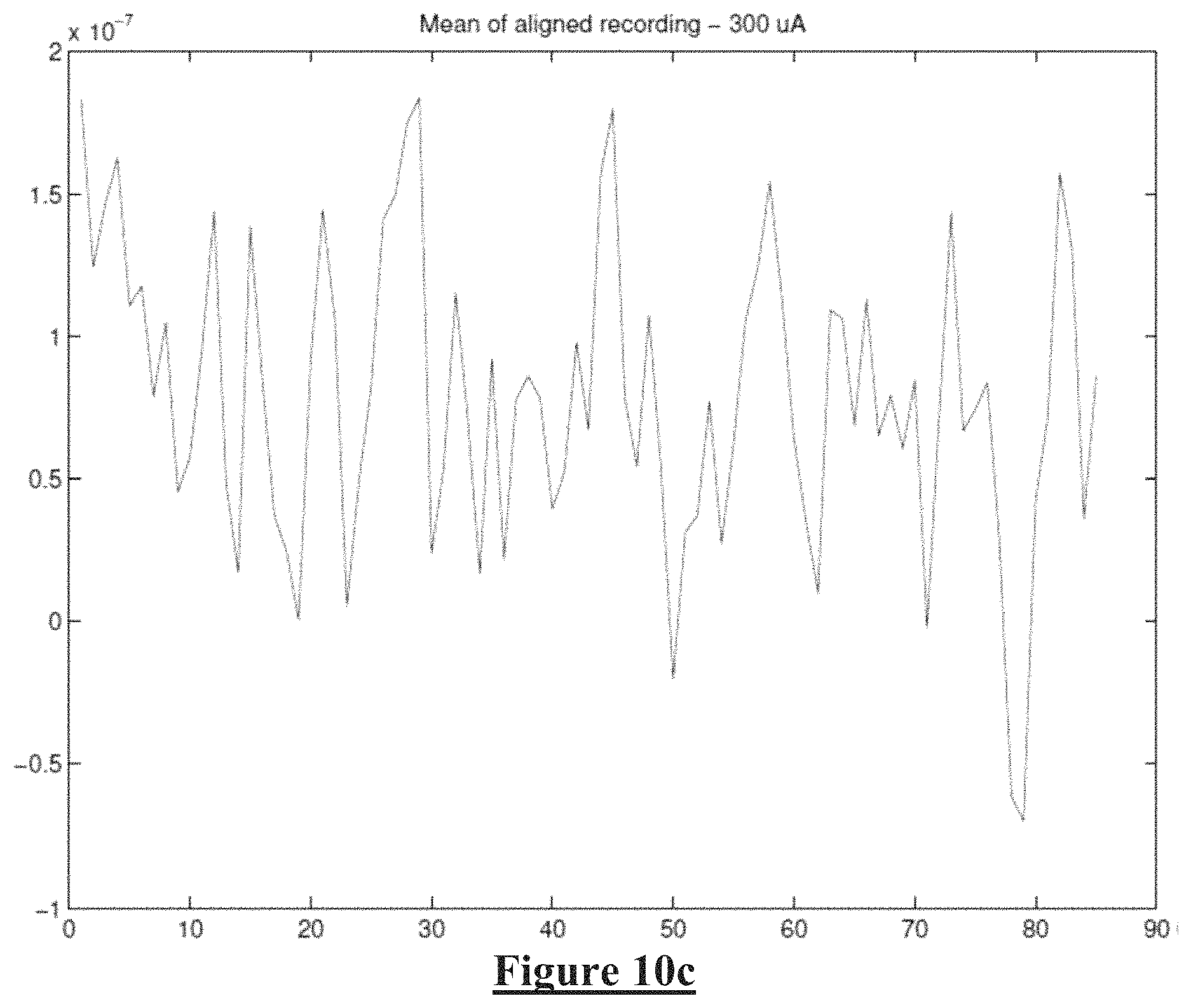
D00013
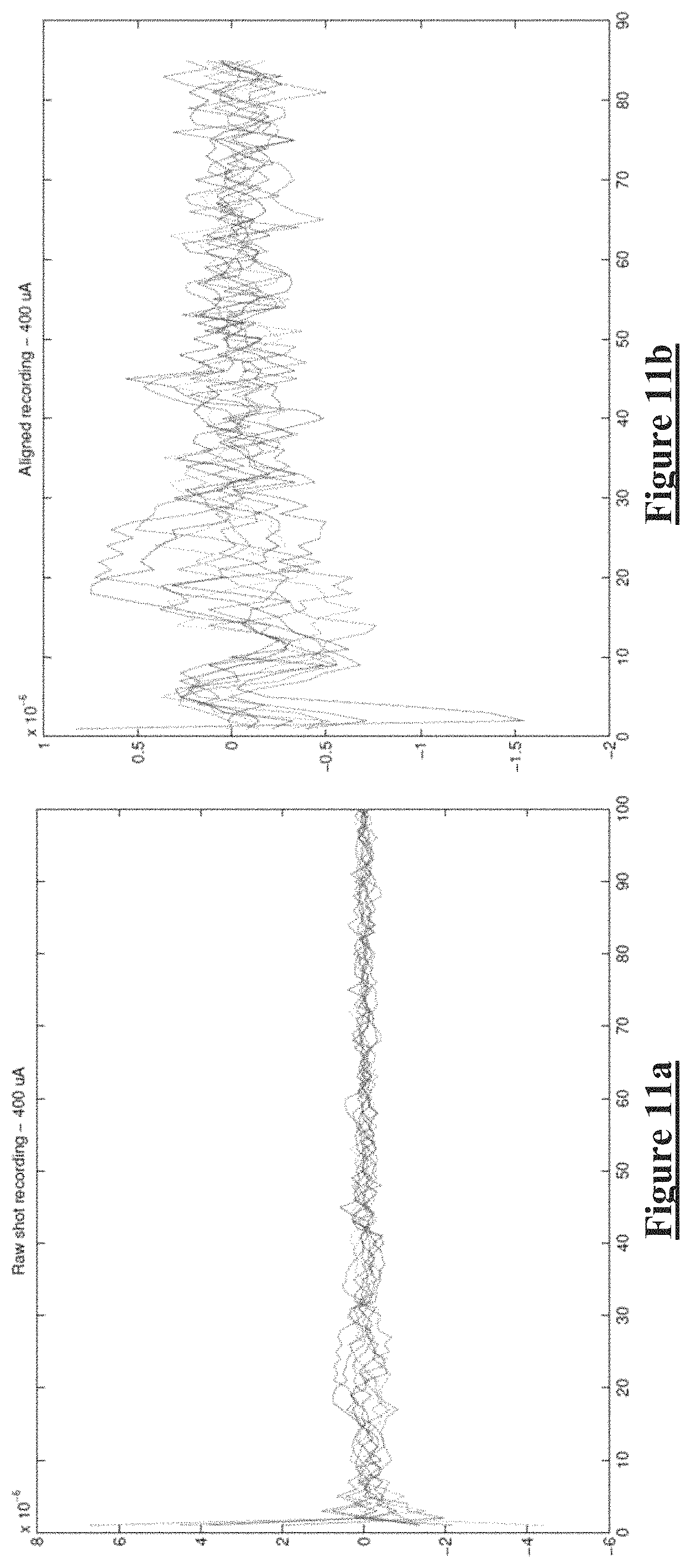
D00014
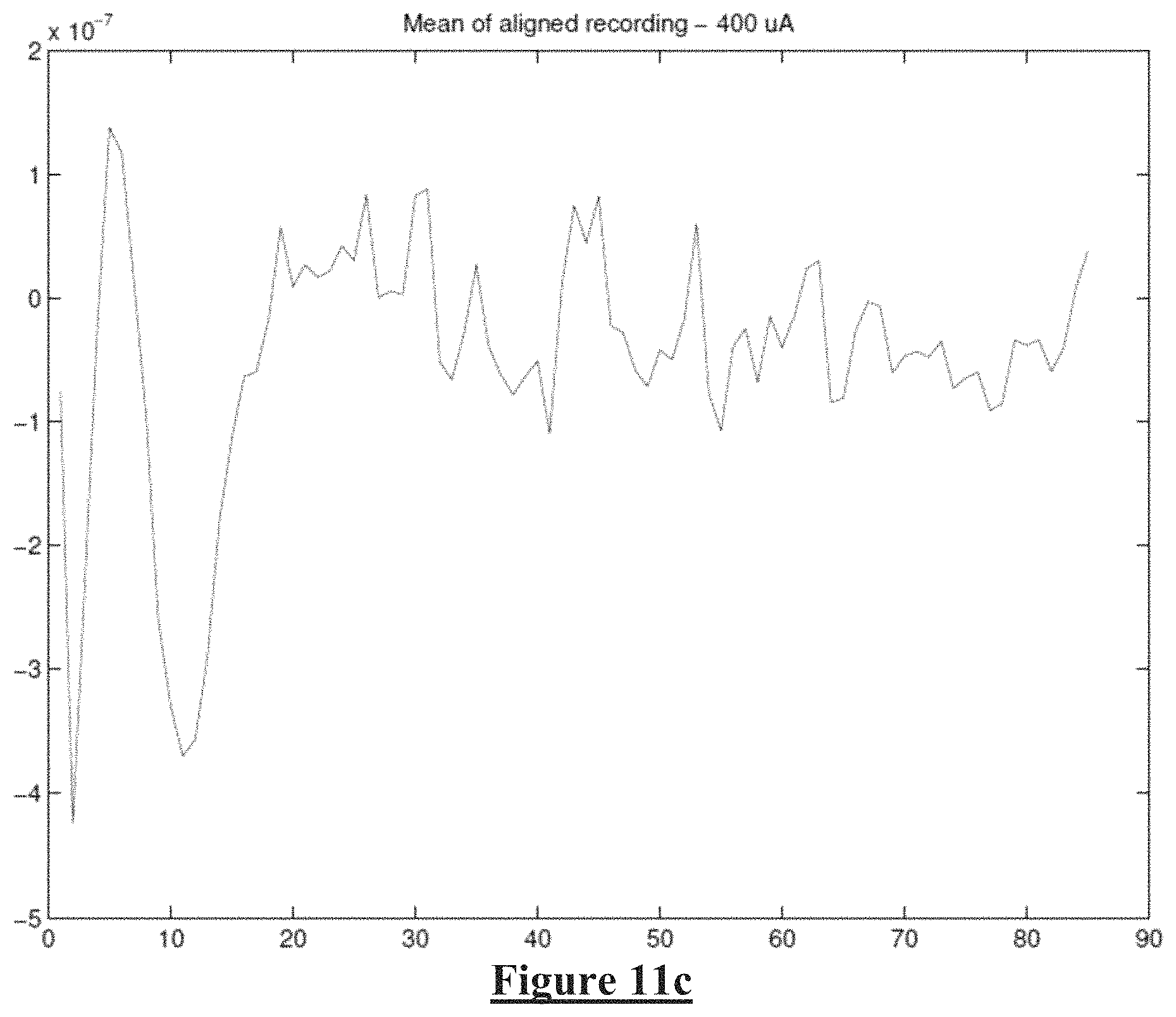
D00015
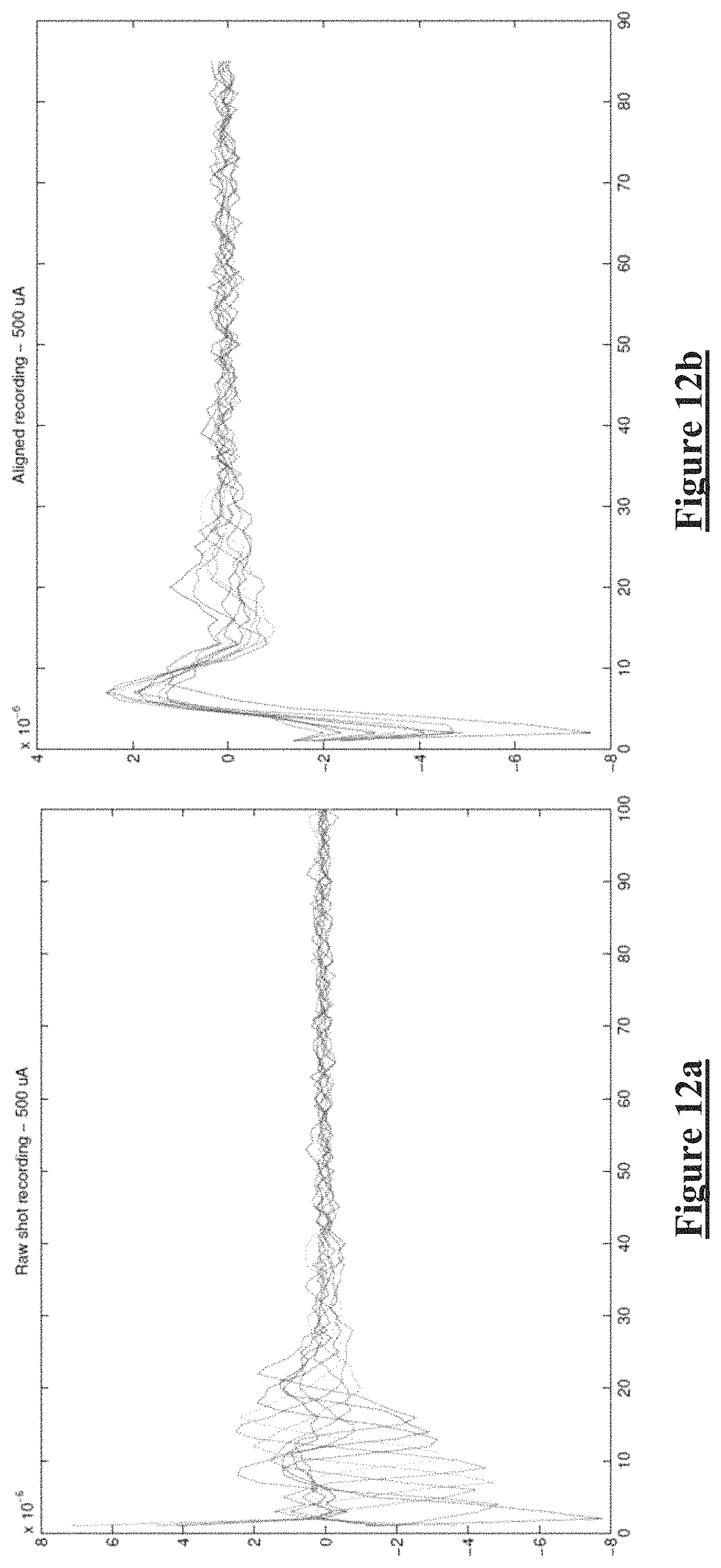
D00016
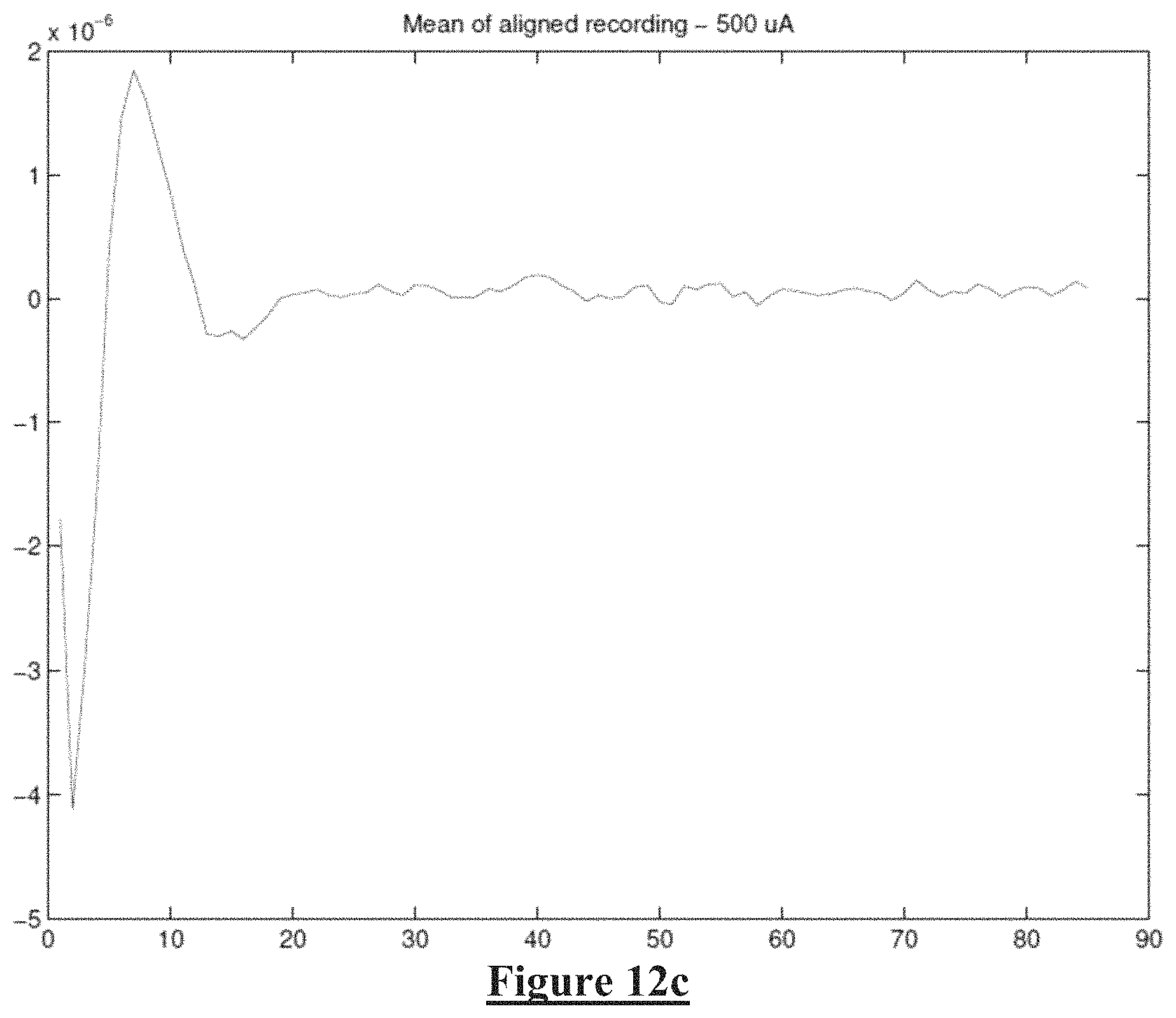
XML
uspto.report is an independent third-party trademark research tool that is not affiliated, endorsed, or sponsored by the United States Patent and Trademark Office (USPTO) or any other governmental organization. The information provided by uspto.report is based on publicly available data at the time of writing and is intended for informational purposes only.
While we strive to provide accurate and up-to-date information, we do not guarantee the accuracy, completeness, reliability, or suitability of the information displayed on this site. The use of this site is at your own risk. Any reliance you place on such information is therefore strictly at your own risk.
All official trademark data, including owner information, should be verified by visiting the official USPTO website at www.uspto.gov. This site is not intended to replace professional legal advice and should not be used as a substitute for consulting with a legal professional who is knowledgeable about trademark law.